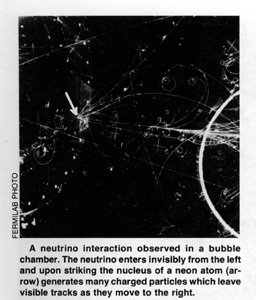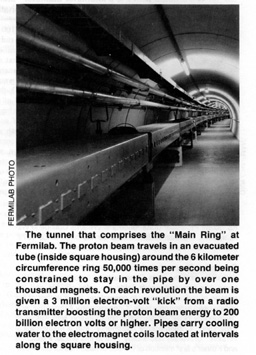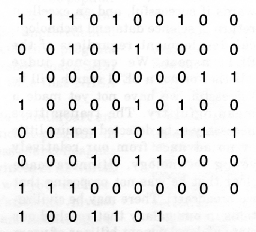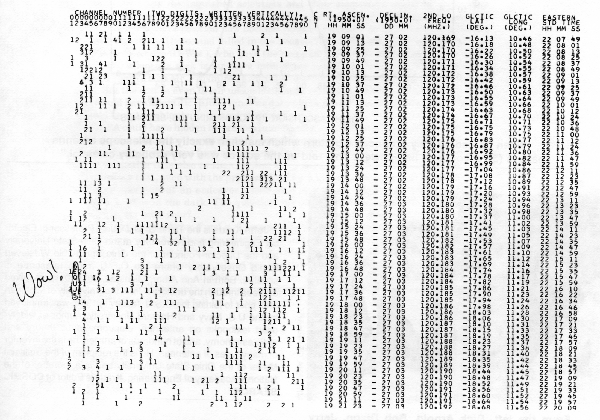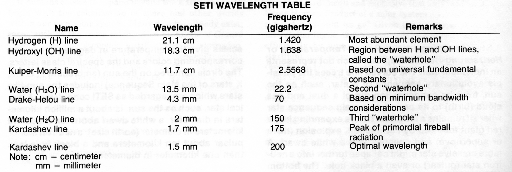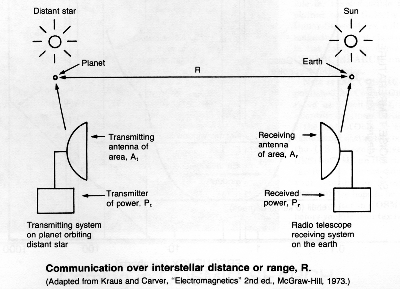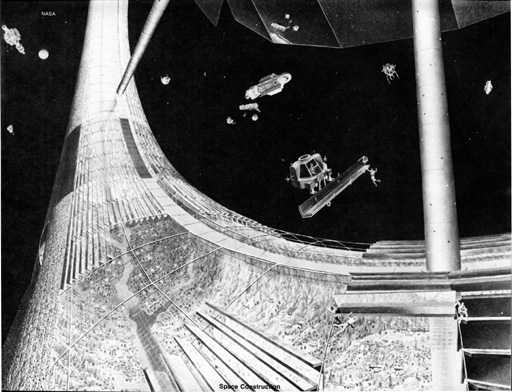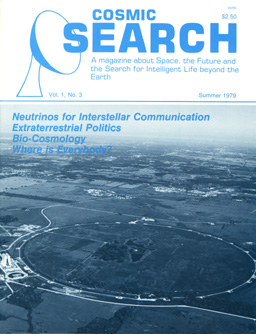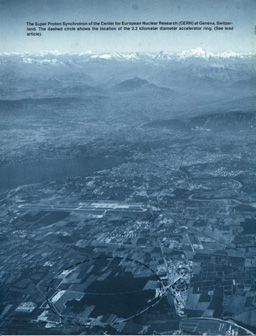![[NAAPO Logo]](../../Images/NAAPOsm.jpg)
North American AstroPhysical Observatory (NAAPO)
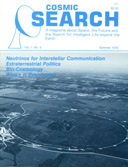
Cosmic Search: Issue 3
(Volume 1 Number 3; Summer 1979)
[All Articles & Miscellaneous Items]
|
Webpage Table of Contents (Bookmarks)
(Internal links to items in this webpage)
[Note. Use Back button (or <Alt>+<Left Arrow>) to get back to this Table of Contents after you have clicked on a link and viewed the article.]
Codes Used Below:
P: Starting page of article in magazine; A: Author(s); T: Title of article
|
Neutrinos for Interstellar Communication
By: Jay M. Pasachoff and Marc L. Kutner
[Article in magazine started on page 2]
In 1888 when Heinrich Hertz first transmitted radio waves over a distance of a few paces in his Karlsruhe, Germany, laboratory, no one could have predicted the vast global and interplanetary radio communication systems of today or that radio telescopes would detect quasars at distances of more than 10 billion light-years. Although neutrino communication is now in a primitive state, like radio in Hertz's time, who can foresee what its capabilities may be 100 years from now?
In this fascinating article, Jay Pasachoff and Marc Kutner assess the "state of the art" and consider its potential for bridging interstellar distances. — Eds.
Though no interstellar communication is going to be quick, it is obviously better to send messages that travel at the highest possible velocity, all other things being equal. Usually this leads to the conclusion that we should communicate with radio or other electromagnetic waves. But one nuclear particle—the neutrino—travels at the speed of light, and the possibilities of using neutrinos as the vehicle for interstellar communication should be carefully explored. Neutrinos turn out to have many advantages for this purpose, along with their major difficulties, and we think that investigation of neutrino communication should not be ignored. We note that we are here exploring possibilities whose realization would be in the distant future. Nonetheless, since most other communicating civilizations would be far more advanced than our own, it is an interesting exercise to examine alternative means by which interstellar communication may have evolved.
Neutrinos
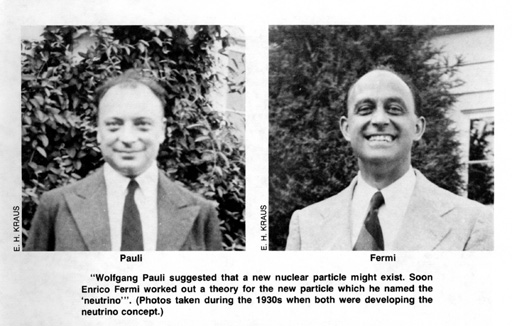 In the early 1930's, Wolfgang Pauli suggested that a new nuclear particle might exist to explain the apparent lack of conservation of energy and spin in beta decay, a radioactive process that involves the emission of an electron (a beta
particle). Soon Enrico Fermi worked out a theory for the new particle, which he named "neutrino," Italian for "little
neutral one," since the particle had no charge and to distinguish it from the "neutron," which had recently been discovered.
In the early 1930's, Wolfgang Pauli suggested that a new nuclear particle might exist to explain the apparent lack of conservation of energy and spin in beta decay, a radioactive process that involves the emission of an electron (a beta
particle). Soon Enrico Fermi worked out a theory for the new particle, which he named "neutrino," Italian for "little
neutral one," since the particle had no charge and to distinguish it from the "neutron," which had recently been discovered.
The neutrino is, therefore, a particle with no charge but with a certain energy and a certain spin. It travels at the speed of light, and in order to do so, it must have no rest mass.
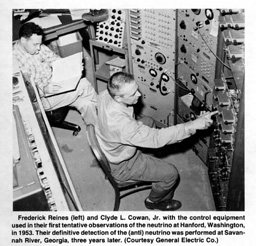 Neutrinos are the most elusive particles of which we know. They have a very low probability of interacting with any other matter. In fact, neutrinos on the average can penetrate four light years of lead before being stopped. Rather than try to detect individual neutrinos, we normally resort to capturing a tiny fraction of a huge number of neutrinos. In this way, Frederick Reines and Clyde L. Cowan, Jr., detected antineutrinos in 1956 in the flood of particles coming from the Savannah River reactor. The existence of antineutrinos shows neutrinos too must exist.
Neutrinos are the most elusive particles of which we know. They have a very low probability of interacting with any other matter. In fact, neutrinos on the average can penetrate four light years of lead before being stopped. Rather than try to detect individual neutrinos, we normally resort to capturing a tiny fraction of a huge number of neutrinos. In this way, Frederick Reines and Clyde L. Cowan, Jr., detected antineutrinos in 1956 in the flood of particles coming from the Savannah River reactor. The existence of antineutrinos shows neutrinos too must exist.
The disadvantage that neutrinos interact so weakly with matter is also an advantage, because this property allows neutrinos to escape from the center of a star. The nuclear fusion cycles that fuel our sun lead to the emission of neutrinos of relatively low energy. These neutrinos come straight out of the solar core, reaching the radius of the earth's orbit in 8 minutes, thus providing us with our only direct link to the solar core.
 Raymond Davis, Jr., of the Brookhaven National Laboratory, has set up a 400,000 liter tank of perchloroethylene (a type of cleaning fluid, C2Cl4) to capture solar neutrinos. His tank is located deep underground in a gold mine (at Lead, South Dakota), where it is shielded by the earth and rock above from other particles that would cause reactions
in his material. He is now detecting 1.8 (±0.4) Solar Neutrino Units (SNUs) of neutrinos (where one SNU corresponds to 10-36 captures per chlorine atom per day, or one capture per day among a trillion, trillion, trillion atoms). This amounts to about one interaction every six days.
Raymond Davis, Jr., of the Brookhaven National Laboratory, has set up a 400,000 liter tank of perchloroethylene (a type of cleaning fluid, C2Cl4) to capture solar neutrinos. His tank is located deep underground in a gold mine (at Lead, South Dakota), where it is shielded by the earth and rock above from other particles that would cause reactions
in his material. He is now detecting 1.8 (±0.4) Solar Neutrino Units (SNUs) of neutrinos (where one SNU corresponds to 10-36 captures per chlorine atom per day, or one capture per day among a trillion, trillion, trillion atoms). This amounts to about one interaction every six days.
Davis' results are lower by a factor of almost three than the best current predictions of the solar neutrino outflow, but within about twice the error (standard deviation) in the theoretical predictions, which give 4.7 (±1.4) SNU. He is planning an experiment using gallium rather than the chlorine presently in his tank, and a Soviet group is also planning a gallium experiment. Gallium is sensitive to lower-energy neutrinos than is chlorine.
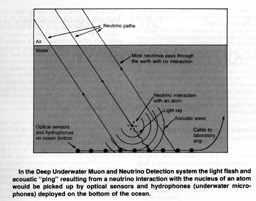 Still higher energy neutrinos should be emitted in supernova explosions. Such neutrinos might be detected by an apparatus being considered in Project DUMAND (Deep Underwater Muon and Neutrino Detection). One plan involves setting up acoustic or optical detectors over an area of several square kilometers on the floor of the Pacific Ocean near Hawaii to detect the Cerenkov radiation emitted when neutrinos interact with nucleons in the water. (Cerenkov radiation is emitted when a particle enters a medium travelling faster than the speed of light in that medium, somewhat analogous to a sonic boom.)
Still higher energy neutrinos should be emitted in supernova explosions. Such neutrinos might be detected by an apparatus being considered in Project DUMAND (Deep Underwater Muon and Neutrino Detection). One plan involves setting up acoustic or optical detectors over an area of several square kilometers on the floor of the Pacific Ocean near Hawaii to detect the Cerenkov radiation emitted when neutrinos interact with nucleons in the water. (Cerenkov radiation is emitted when a particle enters a medium travelling faster than the speed of light in that medium, somewhat analogous to a sonic boom.)
Though neutrinos are very difficult to detect, the scientific benefits of studying the neutrinos that result from stellar interiors or supernovae have made it worthwhile to set up equipment to study them. Continued improvements in the sensitivity of neutrino detection devices can be expected.
Advantages of Neutrino Communication
Much discussion of SETI has been taken up with finding a suitable frequency for radio communication. Interesting arguments have been advanced for 21 centimeters, the water hole, and other wavelengths. It is hard to reason satisfactorily on this subject; only the detection of a signal will tell us whether or not we are right. Neutrino detection schemes, on the other hand, are broad band, that is, the apparatus is sensitive to neutrinos of a wide energy range. The fact that neutrinos pass through the earth would also be an advantage, because detectors would be omnidirectional. Thus, the whole sky can be covered by a single detector. It is perhaps reasonable to search for messages from extraterrestrial civilizations by looking for the neutrinos they are transmitting, and then switch to electromagnetic means for further conversations.
"It may well be that neutrinos are considered by extraterrestrial civilizations to be a more advanced method of communication than radio waves."
Though the means of detecting neutrinos are now relatively insensitive, we must remember that we are in the dawn of the age of neutrino detection. It is only 23 years since the first antineutrinos were detected. It is almost a hundred years, on the other hand, since the detection of radio waves, and our sensitivity to them has increased manyfold. We can expect that in the next decades we will be better able to detect neutrinos from space, both those arising naturally from astronomical phenomena and those carrying messages from extraterrestrial civilizations. It may well be that neutrinos are considered by extraterrestrial civilizations to be a more advanced method of communication than radio waves.
Neutrino beams are currently generated on earth by proton beams impinging on targets in large accelerators. Proton beams are highly directional, and neutrino beams are also highly directional. The present neutrino beam generated at the Fermi National Accelerator Laboratory (Fermilab) in Batavia, Illinois, has a width as narrow as one-tenth of a degree. The beams are so narrow because of the way they are formed. As the incident proton beams become stronger in energy, the resulting neutrino beams become even more directional.
The doubling in energy expected within two years at Fermilab, to be matched by the accelerator at the European Center for Nuclear Research (CERN), near Geneva, Switzerland, will lead to a neutrino beam about one-twentieth of a degree in width. This is twice as sharp as the beam of the Arecibo radio telescope when used at 21 centimeters. At the distance of the star Tau Ceti (12 light years), the neutrino beam will be broad enough* to irradiate all the planets of a system like our own solar system (*Beam width 600 astronomical units (AU). The earth's orbit is 2 AU in diameter and Pluto's is about 80 AU.). Since we have no idea where any planets might be, we would have to cover roughly this scale to be sure we are not missing planets, not to mention the difficulties in the high precision tracking that would be necessary.
"Neutrinos are the most elusive particles of which we know."
An international Very Big Accelerator (VBA) is under discussion as a possible international project on a large scale. This accelerator would generate a proton beam of 10 times higher energy than the new Fermilab and CERN beams. If directed at our solar system from Tau Ceti, this beam would encompass the planets out to Neptune.
Current Terrestrial Neutrino Generation and Detection
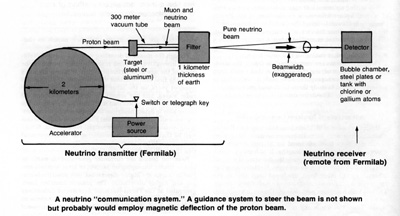 Presently the proton beam generated at Fermilab in the 2 kilometer-diameter ring has energies of 400 billion electron volts. Neutrinos are produced in pulses of 10 billion per pulse with pulses occurring every 8 seconds. The proton beam impinges on a target, resulting in muons, particles of mass intermediate between electrons and protons. The muons travel in a forward direction and their decay products include neutrinos. This forward beam travels through a "filter" of 1 kilometer of earth, which excludes all the particles except neutrinos. To detect the neutrinos, a bubble chamber or an apparatus containing approximately 1,000 tons of steel is used. Even that much steel produces only about 1 interaction per pulse. A person can (and often does) stand in the neutrino beam without any effect on either the person or the beam.
Presently the proton beam generated at Fermilab in the 2 kilometer-diameter ring has energies of 400 billion electron volts. Neutrinos are produced in pulses of 10 billion per pulse with pulses occurring every 8 seconds. The proton beam impinges on a target, resulting in muons, particles of mass intermediate between electrons and protons. The muons travel in a forward direction and their decay products include neutrinos. This forward beam travels through a "filter" of 1 kilometer of earth, which excludes all the particles except neutrinos. To detect the neutrinos, a bubble chamber or an apparatus containing approximately 1,000 tons of steel is used. Even that much steel produces only about 1 interaction per pulse. A person can (and often does) stand in the neutrino beam without any effect on either the person or the beam.
As the proton beam is brought to higher energies, the number of protons per pulse goes up proportionally to the energy. Thus the particle flow (or flux) at a given distance from the ring goes up with two factors of energy from the narrowing of the beam size and one factor of energy from the increase in the number of protons and, thus, neutrinos per pulse. This means that the particle flux goes up with the cube of the energy. For a given neutrino beam the number of interactions in the target is also roughly proportional to the energy. Thus for a one trillion electron volt proton beam, we have calculated that about 50 trillion trillion kilograms (5 x 1025 kilograms or ten times the mass of the earth) of material would have to be located at the distance of Tau Ceti in order to obtain one interaction per day with a neutrino from earth. This is about the rate of Davis' solar neutrino experiment. We are currently comparing prospective fluxes with the natural neutrino background.
With the technology we may expect to have within a few years, we would need ten times the mass of the earth as detector material. However, we must remember that the neutrino pulses are 'on' only about 0.00025 per cent of the time. If this percentage can be raised to even one percent, and the proton beam energy can be brought up another factor of 10, then the detector mass required is less than one millionth the mass of the earth in order to detect one neutrino event per day. This is equivalent to a cubic volume of 100 kilometers on a side, already not too different from the scale of detectors being proposed for Project DUMAND.
We must also allow for further technological development. Already a detection scheme has been suggested that detects muons simultaneously with the Cerenkov radiation. Detecting muons can be achieved by a smaller apparatus. Even though a large detector mass may be required for interaction, the active part (or electronic equipment) involved could be much smaller.
Some investigation of neutrino communication has been underway for sending a neutrino signal through the earth to nuclear submarines on the other side of the earth, but this will require the reduction of the detection apparatus from a cube 100 kilometers on a side to the size of a submarine.
Present Data
Though solar neutrino schemes involve much lower energies than Project DUMAND methods, solar neutrinos represent our longest string of data on interstellar neutrinos. We have examined the Davis records for any sign of obvious messages, and have found none. It seems reasonable that any civilization that chooses to generate strong neutrino beams and point them at a given star would also calculate the appropriate number of neutrinos that inhabitants associated with the star would need in order to
detect the incoming signal. Davis' data involve runs of a month or a few months, with interactions occuring once per day. There is no reason to believe that a neutrino signal need be any shorter in duration than months, nor indeed to be even that short. It seems worthwhile to continue collecting data on a regular basis in order to have long enough data runs to properly search for a signal.
Conclusions
Current plans for neutrino generation coupled with prospective abilities for neutrino detection are beginning to make feasible neutrino messages we might send to be detected at the distances of nearby stars. Though neutrino beams are expensive to generate, this disadvantage may be outweighed by such advantages as very narrow focusing of the transmitted neutrino beam, and the ability to receive from the whole sky simultaneously over a broad range of neutrino energies.
"Though the means of detecting neutrinos are now relatively insensitive, we must remember we are in the dawn of the age of neutrino detection."
On earth, neutrino communications have lagged radio communications by about 100 years, during which time our ability to send and receive radio signals has increased drastically. We can hope for similar improvements in neutrino communications in the next decades.
Technologically the transmission of strong modulated neutrino signals would be a sure sign of an advanced civilization, and we should be looking for such a signal.
Since our transmission of a neutrino signal would involve finding a way of making the neutrino beam track the stars to a high degree of accuracy, the transmission of neutrino signals from earth seems farther in the future.
It may be that neutrino communication is best suited for finding another civilization, after which dialogue could be carried out by electromagnetic means. In any case, if our reasoning of the advantages of neutrino communication is correct, then much of the information now criss-crossing the galaxy could be in this mode.
 Jay M. Pasachoff is Director of the Hopkins Observatory and Associate Professor of Astronomy at Williams College in Williamstown, Massachusetts, where he has been since 1972. Born in New York City in 1943, he received his Ph.D. from Harvard University, and served on the staffs of the Air Force Cambridge Research Laboratory, the Harvard College Observatory, and the Hale Observatories before going to Williams. His major research fields are solar physics and the relation of radio astronomy to cosmology. He is author of the widely-used astronomy texts "Contemporary Astronomy" and "Astronomy Now". Pasachoff's collaboration with Kutner in expanding "Contemporary Astronomy" into a mathematical version, "University Astronomy", led to this article. Pasachoff and Kutner's first mention of the use of neutrinos for communication on an extraterrestrial scale appears in "University Astronomy".
Jay M. Pasachoff is Director of the Hopkins Observatory and Associate Professor of Astronomy at Williams College in Williamstown, Massachusetts, where he has been since 1972. Born in New York City in 1943, he received his Ph.D. from Harvard University, and served on the staffs of the Air Force Cambridge Research Laboratory, the Harvard College Observatory, and the Hale Observatories before going to Williams. His major research fields are solar physics and the relation of radio astronomy to cosmology. He is author of the widely-used astronomy texts "Contemporary Astronomy" and "Astronomy Now". Pasachoff's collaboration with Kutner in expanding "Contemporary Astronomy" into a mathematical version, "University Astronomy", led to this article. Pasachoff and Kutner's first mention of the use of neutrinos for communication on an extraterrestrial scale appears in "University Astronomy".
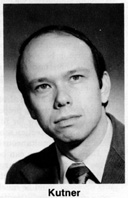 Marc L. Kutner is Associate Professor of Physics at the Rensselaer Polytechnic Institute in Troy, New York. Born in
New York City in 1947, he attended Princeton University for his B.A., and received his Ph.D. from Columbia University. He
was a post-doctoral fellow at NASA's Goddard Institute for Space Studies in New York and was on the Columbia faculty before going to Rensselaer in 1975. His major research field is the radio astronomical study of the interstellar medium. He and Pasachoff have expanded their collaboration into the writing of a new introductory physics text, "Contemporary Physics," for non-major freshmen.
Marc L. Kutner is Associate Professor of Physics at the Rensselaer Polytechnic Institute in Troy, New York. Born in
New York City in 1947, he attended Princeton University for his B.A., and received his Ph.D. from Columbia University. He
was a post-doctoral fellow at NASA's Goddard Institute for Space Studies in New York and was on the Columbia faculty before going to Rensselaer in 1975. His major research field is the radio astronomical study of the interstellar medium. He and Pasachoff have expanded their collaboration into the writing of a new introductory physics text, "Contemporary Physics," for non-major freshmen.
|
|
Letters
By: Editors
[These letters in the magazine were found on page 9]
I would like to express congratulations on developing a journal that I feel is of the first magnitude.
Each Planetarian throughout the world who is a member of the International Planetarium Society should be given the opportunity to subscribe to your fine journal.
Sincerely,
James A. Hooks, President
International Planetarium Society
Dear President Hooks:
Thank you very much and we hope you will continue to rate every issue FIRST MAGNITUDE.
COSMIC SEARCH
Speaking as a person with no scientific training, but with great curiosity about the universe and what lies out there, I find your magazine enthralling.
Elise Jerram
Monterey, California
How wonderful it was to receive your first issue! It seems to me such a magazine is essential to bridging the gap between research and the public. Congratulations and best wishes for a successful venture!
Jeremy Palmer
Venice, California
I want to congratulate you on the fine quality of the premier issue of COSMIC SEARCH. I never before read any magazine from cover to cover. I not only did so with COSMIC SEARCH but did it twice. I will be looking forward to many more interesting articles in future issues of COSMIC SEARCH.
Jerrold B. Winther
Kenosha, Wisconsin
I was really looking forward to the first issue of your magazine and I was not let down as I enjoyed it very much. In fact I read every word in it before I put it down.
Richard Main
Anderson, California
Thank you for your fine article, "ABCs of SETI", in the March issue of COSMIC SEARCH. The section on broadband and narrowband signals was excellently done and was long overdue in the astronomy periodicals.
Albert W. Lotze, Jr.
San Francisco, California
Thank you for the first issue of COSMIC SEARCH. It is wonderful to see it actually come off the press as you said it would, rather than six months late as most new magazines do.
After having read the entire issue I can say that you have put together a fine journal, with a very good Editorial Board. It was a pleasure to read and long overdue.
Kim DeVaughn
Sunnyvale, California
Bach or Beethoven?
May I comment on the small item in the March issue:
"If extraterrestrials ever happen on the Voyager records, we may likely receive a three word message,
SEND MORE BACH."
Although Genius to some extent transcends its milieu, a genius such as Bach, is a human being and his works must be a product of his time and culture. Unavoidably, the music of Bach is an early expression, though a most exalted one, of the Age of Reason in northwestern Europe. In his celebrated television series on (Western European) 'Civilisation,' Sir Kenneth
Clark introduced a program from a library furnished in the style of that period.* (*In "Civilisation: A Personal View," by Kenneth Clark, Harper & Row, N.Y., 1969, page 202.) As he moved towards the doorway he described the Age of Reason as one whose patterns of thought were symmetrical, consistent and enclosed and if the music of Bach were accessible to an alien being these concepts would be transmitted. To beings that have a galaxy to play in, and I use the word play deliberately, the music
of Bach would seem tediously provincial, although one hesitates to use this description for works such as the Sanctus of the B-minor Mass. Sir Kenneth Clark left the eighteenth century and its Age of (Sweet?) Reason behind by crossing the threshold onto
a flight of steps that led down to an ever-rolling ocean, and under a night sky, presumably studded with unseen stars, continued "We must . . . go to confront the infinite." Of course the background music of this presentation could only be the titanic strains of a Beethoven symphony, 'the sound of European man once more reaching for something beyond his grasp.'
If a production of the sonic arts of northwestern Europe were to strike a familiar chord in a culture that faces the challenges of interstellar space, I feel sure that it would be an opus of Beethoven. The music of Bach, sublime though it is, is an expression of a people who had gained an illusion of mastery over their environment, while we, two centuries afterwards,
know that this mastery does not extend to a universe so awesomely unhuman. Only now do our arts have access to an awareness that could be common to other beings who know the vastness of interstellar space.
David G. Stephenson
University of Saskatchewan
Correction
The SEnTInel item in the March 1979 COSMIC SEARCH about the National Radio Astronomy Observatory (NRAO) interferometer is incorrect to the extent that it implied that the Navy had taken over the interferometer.
Hein Hvatum, Associate Director of NRAO, writes: "The Associated Universities, Inc., is still operating NRAO in Green Bank, West Virginia, with all its telescopes and facilities, including the 2700 meter three-element interferometer. However, the
Navy is presently funding the interferometer operation for one year in order to test the feasibility of using a radio telescope interferometer for the time service."
"The invariable mark of wisdom is to see the miraculous in the common."
Ralph Waldo Emerson
|
Extraterrestrial Politics
By: Michael A. G. Michaud
[Article in magazine started on page 11]
 The search for extraterrestrial intelligence may be the first step toward involving the human species in cosmic politics. SETI would perform an ancient and respectable political function: the gathering of intelligence about other political entities. It would be essential in establishing the receiving end of the political communications process. And it may enable intelligent beings to give politics a higher purpose.
The search for extraterrestrial intelligence may be the first step toward involving the human species in cosmic politics. SETI would perform an ancient and respectable political function: the gathering of intelligence about other political entities. It would be essential in establishing the receiving end of the political communications process. And it may enable intelligent beings to give politics a higher purpose.
The Relevant Universe
Each society has its own conception of the relevant universe. Such a shared conception may be evolving among informed humans around the globe. Our recently acquired ability to see the Earth from an extraterrestrial perspective has encouraged us to see our world as a closed, bounded system, and our ecology as a thin layer of minerals, liquid, and gas between the lifeless bulk of the Earth and the cold and dark of space. We have perceived the finiteness of our familiar environment, the ultimate limits to human growth on Earth. Our conception of ourselves as a species has sharpened; we now recognize our common origins and — as long as we all remain on this planet — our common destiny. We are coming to the conclusion that many problems must be solved at the species level, through cooperative action. Joint action on larger scales, for larger purposes, may be crucial for the long-term success of a species whose political subdivisions are armed with increasingly
powerful technologies.
These perceptions may be driving the slow emergence of an ethos of the Earth. That ethos, in turn, may be one of the foundations of the conception of the species as a political entity — a global polis, as the ancient Greeks called the political society of the city-state. But this conception of the Earth and its human cargo sets us off from the cosmos, like a sealed spaceship flying through nothingness; it makes the external environment of the Earth seem irrelevant. This conception of the Earth as a closed world means that, for all practical purposes, our relevant universe is as closed
and geocentric as the astronomical universe was before Copernicus.
Beyond the Limits of the Earth
At the same time, our species has improved its perceptions of its larger environment through astronomy and planetary exploration. Those activities, given new range and acuteness by space transportation, orbiting platforms, and improved sensing technologies, provoke larger dreams by revealing other worlds in unprecedented detail, suggesting that we someday might utilize them as habitats or resources, becoming a multi-planet species. We are in the early stages of a search for extrasolar planets, with its long-term implications of interstellar colonization.
But astronomy also is revealing the true scale of the universe, and is further confirming the non-centrality of the Earth, our solar system, and the Milky Way galaxy. Astronomy invites us outward; at the same time, it makes the universe seem vast, lonely, and empty, encouraging us to turn inward. We feel small, and helpless.
Humankind has made the first tentative extension of its presence beyond the Earth. After initial exploration of nearby space, we began expanding economic and military activity outward; now the major space powers each have interests in space to protect. We have entered the first stage of extraterrestrial politics, an outward extension of the politics we have known on Earth. But we, at least in the West, are still unsure about what long-term human purposes in space should be; we have not decided whether we should enlarge our conception of the relevant universe, and expand humanity beyond the earth.
The Extraterrestrial Paradigm
The terrestrial paradigm — a powerful conceptual pattern — convinces many that Humankind will remain confined to the Earth, and must adjust to that limitation. But there also is an extraterrestrial paradigm which suggests that Humankind should expand outward, utilizing larger resources and living space, ultimately escaping the limits to growth on Earth. To a significant extent, our long-term future will be determined by the relative power of these paradigms, and their political expression. Given the scale of effort and organization needed for large extraterrestrial
ventures, they will have to be the results of societal decisions, and therefore will be political questions.
"Astronomy invites us outward; at the same time, it makes the universe seem vast, lonely, and empty, encouraging us to turn inward."
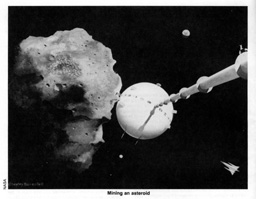 If humans choose to expand beyond the Earth, they will begin with the colonization of space and other worlds within our own solar system. Many designs already exist; some, such as the space colonization proposals of Gerard O'Neill,* (*See interview with Gerard K. O'Neill in the March 1979 COSMIC SEARCH, page 16.) include economic justifications for expansion. These steps might be followed by such macro-engineering projects as the mining of the Moon and the asteroids, the terraforming of Mars and Venus, the transport of outer solar system ices and gases into the inner solar system, and even the rearrangement of the solar system into a form more useful to the human species, perhaps leading to a Dyson sphere around the Sun.
If humans choose to expand beyond the Earth, they will begin with the colonization of space and other worlds within our own solar system. Many designs already exist; some, such as the space colonization proposals of Gerard O'Neill,* (*See interview with Gerard K. O'Neill in the March 1979 COSMIC SEARCH, page 16.) include economic justifications for expansion. These steps might be followed by such macro-engineering projects as the mining of the Moon and the asteroids, the terraforming of Mars and Venus, the transport of outer solar system ices and gases into the inner solar system, and even the rearrangement of the solar system into a form more useful to the human species, perhaps leading to a Dyson sphere around the Sun.
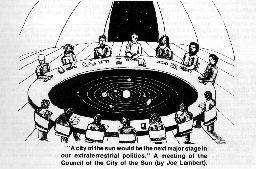 Larger projects would require not only more powerful technologies, but larger scales of economic and political organization, perhaps encouraging the emergence of a solar system civilization. There might be many autonomous biospheres, and independence movements that would challenge central authority. But in time there might evolve a solar polis, a city of the Sun. This would be the next major stage in our extraterrestrial politics.
Larger projects would require not only more powerful technologies, but larger scales of economic and political organization, perhaps encouraging the emergence of a solar system civilization. There might be many autonomous biospheres, and independence movements that would challenge central authority. But in time there might evolve a solar polis, a city of the Sun. This would be the next major stage in our extraterrestrial politics.
There may be a discontinuity in human expansion, and in extraterrestrial politics, at the outer edge of the solar system. Interstellar flight by humans may remain, for a long time, so difficult and expensive that only the expanded Gross Human Product of a solar system civilization could support it. Would we go? Given the problems of human interstellar flight, exploration could be accomplished more efficiently by unmanned interstellar probes. Manned starflight may be undertaken only as a one-way trip, in response to political events within our solar system, to a crisis that threatens human survival, or to a transcendental vision of the human future. In each case, the purpose would be to found human colonies.
Interstellar colonization could begin a new dispersal and diversification of the human species — and a new level of politics. Governing far-flung star colonies from a central point would be difficult if not impossible, unless we find some way to get around or through the structure of space-time as we now understand it. Interstellar colonies would have to be self-sufficient and autonomous. This could lead to independent political entities which might eventually evolve into separate descendant species. However, the centralizing tendencies of politics are strong, and might be aided by scientific breakthroughs and technological change. Instead of fragmenting politically, the expanded human polis might establish new scales of organization, capable of carrying out ever larger tasks: macro-engineering, humanizing, manipulating matter and energy on interstellar scales as ancient oriental empires manipulated water in massive irrigation works. Humans someday may realize the science fiction vision of a galactic society, whether fragmented or centralized in a galactic empire. This would be the next stage of extraterrestrial politics.
At each stage of growth, humans would be expanding their noosphere — their realm of consciousness. But that may be followed by the expansion of the ethosphere, the realm of human values, perhaps leading to the formation of a larger cultural entity and a larger polis.
"Interstellar colonization could begin a new dispersal and diversification of the human species — and a new level of politics."
But humans may never conquer the universe. It is expanding rapidly, its parts flying away from one another. Its scale already has become so vast that humans may never catch up with all of it or mobilize enough energy to organize it and shape it to their design. William Gale and Greg Edwards have calculated that the mass horizon at which half the matter can be prevented from expanding farther is about 1.6 giga-light years — a colossal distance, but not all the universe. Those dimensions may suggest the ultimate limits to the humanization of the cosmos.
Our remote descendants, for all their powers and their expanded scales of political, economic, and technological organization, may still face, as we do, the implications of a universe rushing outward toward a slow, cooling death, or eventually collapsing inward toward a more rapid one.
Either destiny could induce philosophical and political fatalism, a sense of meaninglessness about human existence. Have we evolved to consciousness only to face an irreversible slide toward ultimate collective death, hot or cold?
Other Lives, Other Paradigms
This is where the search for extraterrestrial intelligence has unique significance. If the search is successful, we might enter a long-term dialogue among the stars. We might listen, like children in the Australian Outback tuning in on the School of the Air. Or we might be admitted to a community of intelligences, like Bracewell's Galactic Club. But the assumption that contact among intelligent species could occur only by indirect means, such as radio or some other manipulation of the electromagnetic spectrum, may reflect a bias. Having thought about our own possible future expansion into the universe, we must consider the possibility that other civilizations also might choose to expand.
Other intelligent species which evolved on planetary surfaces may have reached the stage of a planetary civilization, perhaps long before we did. Many, perhaps most, may have accepted a limited, planetary paradigm of their relevant universes and their futures, even if some had developed the technological means to migrate beyond their original biospheres, and the perceptions of external reality to motivate such expansions.
Some of these planet-bound civilizations might conceive of other intelligences in the universe, and might try to detect them or communicate with them. But if such civilizations accepted their planetary ecologies as their relevant universes, how long would they maintain the effort to detect or communicate with others? The search for alien intelligences may be a transient phenomenon; social values and political leaderships change on time scales that are short compared to cosmic and biological evolution.
Some intelligent species with adequate technological powers—possibly a small minority—may adopt extraplanetary paradigms and expand their presence and influence in the universe. They too might form expanding noospheres and ethospheres. But each ethosphere would be species-centered, and each would be different.
Eventually, such expanding civilizations may come into contact. That contact may occur first by radio or some other indirect means. But if interstellar flight is possible, expansion could lead to direct contact, and detection by indirect means could encourage movement toward that event.
What happens when different ethospheres touch? That moment may be the most important turning point in the history of intelligence, after the creation of language and technology. Among civilizations of relatively equal power, it could lead to suspicion, fear, even conflict, to the conception of survival as a zero-sum game. But contact is much more likely to be a demonstration of the politics of inequality. The outcome may depend on the ethos of the more powerful species, on its conception of the value of intelligence in the universe.
"What happens when different ethospheres touch? That moment may be the most important turning point in the history of intelligence."
We can hope that contact among intelligent species will lead to a higher ethos, a larger polis, and the formation of a new scale of organization for social tasks. This may be possible only if the species coming into contact find political solutions to their concerns, or if a superior species has a value system that encompasses the worth of other intelligences. To extend the concept of altruism to another species to strengthen the prospects for the survival of intelligence would be an act of statesmanship of the highest order. Contact, then, would allow — and perhaps require — a new and vastly larger conception of politics and its purposes. It would be, for us, a higher level of extraterrestrial politics.
Survival
The ultimate goal of a community of intelligence, the transcendental vision that gives purpose to the cosmic polis and guides its work, may be to assure the survival of intelligence in a universe that is indifferent to it. This may be the ultimate ethical act — and getting from an atomized diversity of intelligences to a conscious, directed universe may be the supreme political challenge.
If Gale and Edwards are right, no one species can control the universe or shape its future. Only if the intelligent species of the universe work together can they hope to reverse the running down of the cosmos that we measure as entropy, or its collapse into a new primeval fireball. Failing that, it may take their collective knowledge and abilities to find another escape from cosmic death. Cosmic politics, then, may be essential to the long-term survival of intelligence in the universe.
As SETI gets under way, we will be making choices about our own role in the universe through our political decisions about the future of spaceflight, and our attitudes toward the extraterrestrial paradigm. One may argue that our species cannot contribute to the community of intelligence unless we search for evidence of its existence and communicate with it. One also may argue that our contribution will be significant only if we adopt an extraplanetary model of our future, so that we may expand our influence on the universe and join with others in the tasks of assuring long-term survival. If we find no others, these tasks will be ours alone.
 Michael A. G. Michaud is Deputy Director of the Office of International Security Policy, a branch of the U.S. State Department in Washington. He was born in 1938, and received Bachelor's and Master's degrees from the University of California at Los Angeles in political science. He has been with the State Department ever since. His distinguished foreign service career spans a wide range of diplomatic and administrative assignments in Europe, Asia and Australia as well as in the United States. He is author of over 30 publications dealing with the societal consequences of SETI and spaceflight, as exemplified by: "The Consequences of Contact" (American Institute of Aeronautics and Astronautics Student Journal, Winter 1977-78), "Spaceflight and Immortality" (Life Extension Magazine, July/August 1977), and "Interstellar Negotiation", (Foreign Service Journal, December 1972). This same theme is also carried through to his memberships in organizations like the L-5 Society, The British Interplanetary Society, The World Future Society and the Sierra Club. He is also a member of the International Institute for Strategic Studies, The
National Space Institute, The Royal Central Asian Society and the American Foreign Service Association. His unique combination of wide diplomatic experience, interest in outer space and communicative abilities make him a frequent invited participant on panel discussions related to the social aspects of space exploration.
Michael A. G. Michaud is Deputy Director of the Office of International Security Policy, a branch of the U.S. State Department in Washington. He was born in 1938, and received Bachelor's and Master's degrees from the University of California at Los Angeles in political science. He has been with the State Department ever since. His distinguished foreign service career spans a wide range of diplomatic and administrative assignments in Europe, Asia and Australia as well as in the United States. He is author of over 30 publications dealing with the societal consequences of SETI and spaceflight, as exemplified by: "The Consequences of Contact" (American Institute of Aeronautics and Astronautics Student Journal, Winter 1977-78), "Spaceflight and Immortality" (Life Extension Magazine, July/August 1977), and "Interstellar Negotiation", (Foreign Service Journal, December 1972). This same theme is also carried through to his memberships in organizations like the L-5 Society, The British Interplanetary Society, The World Future Society and the Sierra Club. He is also a member of the International Institute for Strategic Studies, The
National Space Institute, The Royal Central Asian Society and the American Foreign Service Association. His unique combination of wide diplomatic experience, interest in outer space and communicative abilities make him a frequent invited participant on panel discussions related to the social aspects of space exploration.
|
Editorial: "The Stars on Radio"
By: The Editors
[Article in magazine started on page 15]
On Sept. 19, while Menachem Begin and Anwar Sadat were down the hall, besieged by newsmen, a quiet little hearing was going on in the Rayburn Building before the House subcommittee on space science and applications, on the subject of the "Search for Extraterrestrial Intelligence." The cruel among you will now observe that the House might better limit its searches to terrestrial intelligence, but in fact the subcommittee had before it some fine examples of earthly brain work in the testimonies of Richard Berendzen of American University, Philip Morrison of the Massachusetts Institute of
Technology, A. G. W. Cameron of the National Academy of Sciences and several others. All of them had come to argue for a $14-million appropriation ($2 million a year for the next seven) to the National Aeronautics and Space Administration to improve radio technology, so that we may eventually determine if anybody up there likes us.
Actually, those distinguished scientists and their supporters would be more than pleased simply to hear from anybody up there, affection notwithstanding. They are placed in a defensive position now because NASA's proposal for FY79 has already been chopped up in the House and killed in the Senate. Naturally, one of the killers was Sen. William Proxmire (D-Wis.), who gave the proposal his Golden Fleece award, although what the scientists seek is far more interesting than Jason's quarry. The question of relative worth that Mr. Proxmire's award awkwardly implies, of course, is an old and real
one. But the cost — even to our unscientific ears — sounds awfully low for a project that
(1) would have scientific value even if we didn't hear a peep from the other planets and (2) would be astonishingly important if we did.
NASA could have hidden its proposal among other, less "scary" line items in its budget, since radio astronomy is a perfectly acceptable area of inquiry, without mentioning the search for transmissions from outer space. That NASA chose to play the matter straight is to its credit. It is also to the credit of the parent House Committee on Science and Technology that, even with the proposal dead for FY79, the committee still took the time to learn more about an endeavor whose own proponents admit may turn out to be a perpetual shot in the dark. The question now is: What happens when the proposal is raised again next year?
The answer should be: Fund it. There are plenty of social reasons against doing so, as there always are. And there are scientific reasons, too, since even some radio astronomers do not wish to divert their current work to a cause where the odds are so poor. But this is not one of those situations where we are likely to know without trying. The most interesting element in all this is that, if we ever should receive a comprehensible message, it will probably have been intentionally sent — meaning that whoever is up there has something to tell us. Perhaps to push ahead.
THE WASHINGTON POST
Sept. 30, 1978
The Editors: Reproduced by permission.
|
|
Bio-Cosmology: A New NASA Thrust*
By: B. M. Oliver
[Article in magazine started on page 16]
*Presented by invitation in September, 1978, for the consideration of the Sub-committee on Space Science and Applications of the U.S. House of Representatives.
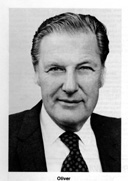 It is suggested herein that NASA should undertake a broad program of research to elucidate the origin of life in the universe, to assess its possible diversity and plenitude, and to seek evidence of such life including a search for extraterrestrial intelligent life (SETI). A short description of a rational SETI program is given. It is argued that such a program should concentrate on a targetted search, broadened to include an all sky survey only after a large scale high sensitivity system is available.
It is suggested herein that NASA should undertake a broad program of research to elucidate the origin of life in the universe, to assess its possible diversity and plenitude, and to seek evidence of such life including a search for extraterrestrial intelligent life (SETI). A short description of a rational SETI program is given. It is argued that such a program should concentrate on a targetted search, broadened to include an all sky survey only after a large scale high sensitivity system is available.
Today, the universe is believed to be about 15 billion years old. At birth, it was an enormous fireball of elementary particles and hard radiation that either flashed into existence for unknown (and perhaps unknowable) reasons, or else it represents the crushed remains of an earlier
universe recycling itself. The fireball rapidly expanded and cooled into hydrogen, a little helium and a fading blaze of light. At 10 million years of age the gases had begun to clump into vast clouds that ultimately were to become galaxies, billions of them, each with hundreds of billions of
stars, but as yet there were no stars and "darkness was everywhere on the face of the deep".
Then came the first massive stars and again there was light, not a uniform blaze now, but quadrillions of pinpoints arranged in gigantic pinwheels throughout space — a universe superficially much like the one we see today, but in reality very different. This early universe was composed only of hydrogen and helium. It could have no rocky planets on which life could evolve for it did not contain any of the heavier elements needed for rocks and for living things.
These heavy elements were manufactured in the cores of long-dead massive stars whose explosive deaths then hurled them back into space. The calcium in our bones, the carbon in our tissues, the iron in our blood, and the oxygen we breathe were all made by stars that blazed unseen in the early universe. We are indeed little bits of stardust. So is the earth itself, so indeed are countless quadrillions of rocky planets that circle later generations of stars—stars formed, along with their planets, from the interstellar gas enriched with dust from the earliest exploding stars. Earth-like planets are now thought to accrete out of stardust alone; nickel-iron meteorites, stony meteorites, and carbonaceous chondrites: tarry clumps of sand that may account for petroleum. The hydrogen and helium, so common on the outer giant planets was probably swept away near the young sun leaving only small rocky planets devoid of atmospheres. The atmospheres of Venus, Earth, and Mars are the result of gases poured out of volcanoes: steam, carbon dioxide, methane, ammonia, and many others.
When a mixture of gases like those in the primitive atmosphere is exposed to sunlight the chemicals needed to produce DNA and organic matter are formed in great quantities. On earth we think these rained down into the early seas to make a "chicken soup" in which life began, and began quickly. Over the early aeons the blue-green algae kept extracting the carbon-dioxide from the atmosphere as fast as the volcanoes poured it forth, converted it to organic matter and freed oxygen. When enough oxygen had accumulated, animal life appeared.
On Venus, the temperature was too high for seas to form, life did not start, the carbon-dioxide accumulated into a crushing atmosphere that now suffocates the planet. The hundred fold heavier atmosphere of Venus is a blanket that lets sunlight in, but won't let the planet's radiation out. Venus is hot enough to melt lead. If it hadn't been for life—for all those blue-green algae—earth would be like Venus. We owe our blue skies and green hills to a living fossil that stubbornly refuses to be killed in our swimming pools.
The Miracle
But wait! How can we accept all this so calmly? Isn't science describing a miracle to us? If you were to witness the fireball of creation, would you ever believe that in only 15 billion short years, through the wonderful laws of physics and chemistry, some of the matter of that fiery chaos would have evolved itself into apple blossoms, into birds and eyes, and into minds? In 15 billion years, a small part of the universe now contemplates the whole of it. Man is always seeking the miraculous. What greater miracle could there be than the one spread before us?
But there is more to this miracle. We know of nothing unique about earth that might have restricted life to this planet. Indeed, we believe that there may be as many as 10 billion "good" earths circling "good" suns in our Galaxy. And there are billions of galaxies. If so, then intelligent life is a common phenomenon in the universe.
Advanced cultures probably besprinkle the Galaxy, but even if there are millions of them they will be so far from one another on the average that, with rare exceptions, none can afford to cross the gulfs of space to visit their nearest neighbors, even if they knew where those neighbors live. Decades of science fiction have beguiled the popular mind into accepting interstellar travel as a future reality for us, and a present reality for other races. Yet the hard facts are that, even with no technological limitations, interstellar flight is so costly in time, or energy, or both, as to be
economically impossible, except in extremis.
Are these advanced cultures forever to exist in isolation? We think not, for we already have the technology with which to detect them and ultimately to communicate with them. Existing radio telescopes, if pointed in the right direction and tuned to the right frequency, could detect their counterparts clear across the Galaxy. Could, but never will, unless a rational search strategy is established and adhered to for an extended period of time. Such a program is SETI—The Search for Extra-Terrestrial Intelligence.
Bio-Cosmology
But SETI is only part of a broader program, which I am calling bio-cosmology. This encompasses all research aimed at explaining the origin of life, of predicting the frequency and location of highly evolved life, and of searching for that life by the most promising method or methods. Bio-cosmology could include something as apparently unrelated as searching for petroleum or methane in deep pre-organic formations for, if Thomas Gold is right and the earth is full of primodial hydrocarbons, it would mean that petroleum is not the result of some special geologic era on earth and that other habitable planets would have oil for their beginning technologies. It would incidentally mean that we have much more than we presently think.
From time-to-time, as new discoveries are made, new topics may appear as desirable additions to a bio-cosmology program while others may drop out. For the present, I would recommend that the program comprise the following subjects:
1. Extra-solar planetary detection.
Theory today suggests that planetary systems should accompany most stars. We think they do, but we do not know. If we could determine the frequency of planetary systems and in particular, of earth-like planets, we would be more confident of our estimates of the number of advanced cultures that now exist. If we discovered that only certain classes of stars had suitable planetary systems, it would reduce the number of target stars to be searched.
Attempts have been made over many decades to infer the existence of planets around nearby stars from apparent wobble in their position, as the planet swings its heavier partner around their common center of gravity. It now appears that these observations are too full of instrumental errors to be significant.
Ames Research Center has conducted two workshops and one summer study on planetary detection and has concluded that more powerful approaches can be brought to bear. Two, in particular, require special instruments in space and would be excellent shuttle missions.
One scheme proposes to spin an infra-red interferometer around the line of sight to a star, causing any planet, in effect, to appear to orbit at high speed. As the planet passes in and out of the fringes of the interferometer, a modulation in the output signal will occur. Because the brightness of the planet compared with the star is much higher in the infra-red, the modulation should be detectable.
The other scheme involves a telescope so constructed that the light of the star image does not diffract and scatter into a disc large enough to drown the planet. The planet would then be visible as a very faint object. Three exposures taken over a period of 1/4 to 1/2 of its year would show it to be a planet in orbit and not a background star.
One advantage of direct imaging is that one might just possibly be able to do colorimetry on the planet and star. Only planets with oceans would be expected to be bluer than their star, only planets with chlorophyll or its equivalent would be expected to be greener. Thus it could happen that the first extraterrestrial life would be detected in an extra-solar planetary search program. Not intelligent life perhaps, but self-replicating organisms abundant enough to paint the planet as blue green algae once did here, as grass and trees do now. I recommend strong support of the Ames planetary detection program.
We probably will never be able to observe planets around any but the nearest 100 or 200 stars. We may be able to detect only giant planets. Good statistics on the frequency of good earths may have to come from theory rather than observation. Theoretical studies such as those of Cameron and others deserve continued support.
2. Studies of the Origin of Life.
The chemical precursors of life, the amino-acids, polypeptides, etc., can be formed in a variety of ways, some of them are even detected in interstellar space. But the bridge, or bridges, by which these precursors become DNA and by which DNA developed into the living cell, have not been discovered. We think the process occurred very rapidly on earth, perhaps in no more than a century, but our beliefs would be more convincing if we could demonstrate a likely route or even let life form again by the same route. Then we could say with confidence: see, it will happen everywhere! Archeo-biochemistry should be given further support.
3. Evolution of Intelligence
Intelligence is thought to have survival value and therefore to be favored in natural selection. The sentient organism withdraws from danger, the insensate organism does not, the intelligent animal uses better strategies to seek food, avoid danger and protect its young than the stupid animal. But are those factors sufficient to produce social beings with high probability, or are we rare exceptions? If they had not been mysteriously extinquished, would the dinosaurs have evolved into intelligent social species, or do only mammals do this? A number of unanswered questions make our estimates of the frequency of intelligent life uncertain. If sensible programs attacking those questions can be defined, they deserve support.
4. The Search for Extra-Terrestrial Intelligence (SETI)
It might be argued that SETI should be delayed until we find answers to all of the uncertainties in our estimates of the amount of extra-terrestrial intelligent life. Won't our technology continue to improve and make the job easier? Won't some totally new form of communication be discovered that would obsolete present ideas? The answer is no; we should begin now.
No matter how much study we give the problem, certain questions will remain and the search will still be a gamble. We will probably never know the average longevity of advanced civilizations, for example, and the number around us depends directly on this factor. We can say that those who do search successfully probably increase their longevity enormously.
Our technology will improve, but not significantly. Our receivers are almost as sensitive as theory allows. Our data processing technology will improve a great deal, but it is already adequate and a small part of the cost. But most important, any improved technology will be useless if we delay too long. The microwave spectrum, where we must search, is filling up with interference. If we do not get busy and stake out certain appropriate bands for SETI (and search these and others while we can) we may forever close our only window on other life, dooming the human race to galactic isolation.
It is very unlikely that any new and superior form of communication will be discovered, but one cannot guarantee this. However, it is irrational not to use existing means just because some day superior means may be found. This way one can forever rationalize doing nothing. Columbus did not wait for jet aircraft to be developed.
A Rational SETI Program
Since the central theme of this meeting is SETI in particular, and not so much the other aspects of bio-cosmology, let me describe at this point what I believe to be a rational SETI program. It is the culmination of two decades of thought on the subject by interested scientists and engineers.
First of all, to signal across the gulfs of space, something—some physical particle or form of energy—must be sent and received. Of all the various candidates for this task electromagnetic waves, which cover the wide spectrum from radio through light to x-rays turn out to be the best. And, out of all this wide spectrum, the portion known as the microwave region requires the least signalling energy. At lower frequencies, the Galaxy gets very noisy and more power is needed to override this noise. At higher frequencies, the noise increases because the signal itself gets "lumpy". Each photon has more energy so more power is required to receive a given number per second. In the microwave region both of these sources of noise become less than the cosmic radiation of the "big bang".
The more of the spectrum and the greater the number of directions we have to search in a given time, the less time we can spend on a given frequency channel and given direction. The signal must therefore have more power to deliver enough energy in this shorter time, which says our receiving sensitivity is less. The conventional wisdom of SETI is therefore to find ways of reducing the amount of spectrum to be searched and the number of directions in which we must look.
In the microwave region, certain cardinal frequencies have been identified. Cocconi and Morrison in 1959 pointed out that the hydrogen line at 1420 MHz was a naturally marked frequency in the best part of the spectrum. The Cyclops team in 1971 extended this concept, by observing that the hydrogen and hydroxyl lines define, between them, a relatively narrow frequency band in the best part of the spectrum. Because H and OH together form water and because water is a symbol of life, the team dubbed this band the "water hole" and suggested that this might be where different Galactic intelligent species meet. A rational SETI program would search this band thoroughly, but not exclusively.
It is hard to conceive of intelligent life evolving and existing anywhere except in the vicinity of certain middle class stars: isolated main sequence, F, G, and K stars, not too different from our own sun. A rational SETI program would concentrate its search in the direction of such stars, beginning with the closest and proceeding to greater and greater distances from the sun as the receiving sensitivity was increased.

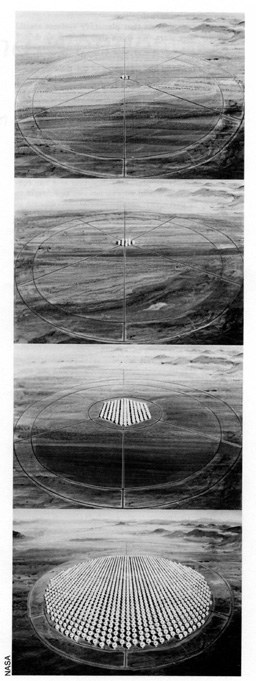 The Cyclops study (1971) showed that it was technologically feasible, if it became necessary, to construct phased antenna arrays having collecting areas equivalent to a single antenna kilometers in diameter. Because we made artists renderings of such an array and showed these pictures widely, this huge array costing tens of billions of dollars, has become synonymous with SETI in people's minds. They think an antenna array of this size is needed to ensure success. This may be true, but it is also possible that SETI could succeed with only one antenna. If we must depend upon overhearing leakage signals—eavesdropping on signals not intended for us—and doing so out to 100 light years we'd need the full array. But suppose within that range another civilization has built a huge array of 2000 antennas. Having detected no signals during their initial search, they now use the array half of the time to beam signals at the 2000 good suns within 100 light years of them. Our sun would be one of those stars and half of the time a signal would fall on earth strong enough to hear with one antenna. Thus a rational SETI program begins with a single antenna and grows by stages only if necessary. This is the Cyclops concept.
The Cyclops study (1971) showed that it was technologically feasible, if it became necessary, to construct phased antenna arrays having collecting areas equivalent to a single antenna kilometers in diameter. Because we made artists renderings of such an array and showed these pictures widely, this huge array costing tens of billions of dollars, has become synonymous with SETI in people's minds. They think an antenna array of this size is needed to ensure success. This may be true, but it is also possible that SETI could succeed with only one antenna. If we must depend upon overhearing leakage signals—eavesdropping on signals not intended for us—and doing so out to 100 light years we'd need the full array. But suppose within that range another civilization has built a huge array of 2000 antennas. Having detected no signals during their initial search, they now use the array half of the time to beam signals at the 2000 good suns within 100 light years of them. Our sun would be one of those stars and half of the time a signal would fall on earth strong enough to hear with one antenna. Thus a rational SETI program begins with a single antenna and grows by stages only if necessary. This is the Cyclops concept.
As soon as the SETI array exceeded four 100 meter antennas, it would be the most powerful radio telescope on earth. A rational SETI program would share this facility with radio-astronomy some appropriate fraction of the time. Quite probably the array would repay its debt to society on the basis of its radiondash;and radar–astronomy discoveries alone.
At the outset, with only a single antenna the sensitivity is low, even for a targeted search. Nevertheless, certain kinds of beamed signals would be detectable, as we said. For an all-sky survey covering about one-eighth of the microwave spectrum in the same time using one antenna, the sensitivity would be about one ten-thousandth as great. The sky survey is intended to receive signals from beyond 100 light years since anything closer would be picked up in the initial targeted search. But to be picked up on the all sky survey, a transmitter at 100 light years would have to beam 100 million watts at us with a 100 meter antenna. To do this for all the stars within 100 1ight years of them would take 200 billion watts, or roughly the electrical power consumption of the U.S. Beyond 300 1ight years, there would be so many stars to beam signals at that they'd give up beaming and radiate in all directions. The sky survey would then find them only if they radiated into space as microwaves the power of a million nuclear power stations. Thus it is difficult to imagine sources powerful enough to be discovered with a small scale sky survey that are not also close enough to be discovered with a small targeted search. Only when and if a very large facility has been constructed and targeted searches of long duration out to great distances are being conducted would a sky survey using the same antennas at the same time be cost effective. A rational SETI program would concentrate on a targeted search, piggybacking a sky survey using the same system.
Conclusion
I recommend the above programs in bio-cosmology as a continuing mission for NASA. I say continuing because one cannot say: In five years we will find other intelligent life, or in three years we will discover how life began. The program is a mixture of research and exploration. If we knew what we will find, we would not have to embark.
This discovery of other life is not only a legitimate mission for NASA, it is an essential one without which popular interest and support will fade. It is probably fair to say that NASA exists because it was felt that a space program might discover other life in the solar system. We now know that won't happen; we must look deeper into space.
In my opinion, bio-cosmology would enjoy great popular support. Even unscientific motion pictures and fraudulent books regarding extraterrestrial life enjoy unprecedented popularity. Surely a soundly based, scientific program would be accepted. In fact, most laymen assume that a SETI program is already going on. It is high time that NASA lived up to this popular belief.
Even if this committee and your senate counterpart endorse bio-cosmology and SETI, a significant program in this area will never become a reality unless your colleagues in the appropriations committee are convinced of its worth. It is a futile exercise to plan for years, to win your endorsement, to win the support of the President's Science Advisor and of the OMB, only to have the House and Senate appropriations committee strike the program from the budget. Of course, the budget must be controlled. But let us do this by eliminating large programs that are failures, not by practicing infanticide. If our penury prevents us from initiating new programs we are indeed lost. You prune a tree by sawing out old dead branches and balancing its shape, not by nipping off new buds. That's the way to kill a tree!
You must help to clear these political roadblocks or NASA will never be able to embark on this exciting electronic voyage of discovery. Help us convince our "Ferdinands and Isabellas", and we may show you completely new worlds, perhaps even a federation of new worlds comprising the mainstream of life in the Galaxy.
 Bernard M. Oliver is Vice-President of Research and Development for the Hewlett-Packard Co. and a member of its Board of Directors. Born in Santa Cruz, California, in 1916, he received the Bachelor's degree from Stanford University in 1935 and his Master's and Doctor's degrees from the California Institute of Technology in 1936 and 1940, respectively.
Bernard M. Oliver is Vice-President of Research and Development for the Hewlett-Packard Co. and a member of its Board of Directors. Born in Santa Cruz, California, in 1916, he received the Bachelor's degree from Stanford University in 1935 and his Master's and Doctor's degrees from the California Institute of Technology in 1936 and 1940, respectively.
From 1940 to 1952 he was employed at the Bell Telephone Laboratories in television and radar development and in 1952 he joined Hewlett-Packard. Dr. Oliver is the author of numerous technical articles and holds over 50 patents in the field of electronics. He is a member of the National Academy of Engineering and the National Academy of Sciences. He has served as president of the Institute of Electrical and Electronic Engineers and is the recipient of the Institute's Lamme Medal. Oliver's SETI activities span many years and includes being Co-Director of the NASA-Ames Project Cyclops (1971). He is a member of the Editorial Board of COSMIC SEARCH, contributing an editorial in the March 1979 issue on "Let's Get SETI Through Congress".
|
|
MINDS AND MILLENNIA:
The Psychology of Interstellar Communication
By: Michael A. Arbib
[Article in magazine started on page 21]
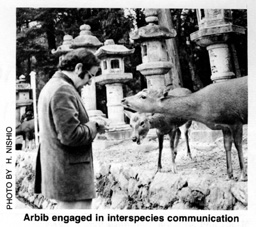 If we establish communication with a civilization even as close as 100 light years from Earth, the round-trip time for a message and its reply is 200 years. What will be the psychology of a civilization which can engage in a meaningful conversation with this sort of delay? How is such a conversation to be established? What should the content of such a conversation be? These are the questions which motivate our title: "Minds and Millennia: The Psychology of Interstellar Communication".
If we establish communication with a civilization even as close as 100 light years from Earth, the round-trip time for a message and its reply is 200 years. What will be the psychology of a civilization which can engage in a meaningful conversation with this sort of delay? How is such a conversation to be established? What should the content of such a conversation be? These are the questions which motivate our title: "Minds and Millennia: The Psychology of Interstellar Communication".
Intelligence and Language
There seems to be general agreement that a civilization which engages in interstellar communication must have achieved the technological capability for radio astronomy, and it is felt that radio astronomy cannot be developed without a solid underpinning of physics and applied mathematics. Thus, while there may be many types of intelligence which do not achieve mastery of the physical sciences as we know them, it does seem reasonable that those intelligences with which we communicate will have a certain amount of basic mathematical and physical knowledge in common with us. This commonality will in fact be the key for the strategy for establishing communication.
However, let us first focus upon the nature of mind, and the role of language. One of the fascinations of the question of the possibility of interstellar communication is that it forces one to look at old philosophical problems from a new perspective. We do not abstract from the nature of human thought in building a philosophy of mind, so much as we try to build a science of mind which is rich enough to embrace not only human minds, but also the still somewhat limited minds of computers, and a whole range of possible minds that we might encounter elsewhere in the universe.
What, from this perspective, constitutes intelligence? It seems to me that the crucial aspect is to be able to adaptably, flexibly, and predictively "model" the environment — representing aspects of current experience in such a way that one will be able to handle oneself better in novel situations in the future than one could have without the current interactions.
However, even among terrestrial organisms, intelligence is by no means limited to humans — dogs can certainly learn from experience. What does seem to be a turning point in evolution on this planet is the development of a separable symbol system for non-hereditary, non-imitative transfer. With language, we can tell people about situations they have not yet encountered, and tell them how to react. For other animals, non-hereditary transfer seems to be based on imitation — the infant either imitates an older animal, or gains experience from play.
One of the most important aspects of language is that it frees us from the here and now. It also frees us from what is
definitely the case. It must be able to express temporal relations: after you have seen such-and-such then you may do so-and-so; it must include a denial: no, it is not the case that such an approach will be effective; and it must include quantifiers: the ability to assert that some things have one property, and that all things have another property. We cannot build a technology on a scientific basis without the ability to make and test hypotheses and look for unifying laws — and the very nature of a hypothesis is that it describes a wide range of circumstances and may not necessarily be true.
It is for this reason that one needs a language made of symbols which can be rearranged in arbitrary fashion, thus transcending imitation or the transmission of pictures of actual events. The trouble with pictures is that they are too literal to communicate general truths: imagine a picture which adequately conveys a theorem about polynomials, or which conveys the negation of a statement. However, the fact that we need a language that transcends literal or pictorial representation of that which is, does not deny that pictures can enhance a symbolic message. For example, in addition to communicating mathematical statements to a creature on another planet, we might also find it worthwhile to establish a picture of our stellar environment as seen from space, and thus provide a clear indication of our location in the universe.
"Another intriguing question raised is the question of how intelligent we really are..."
The last comment suggests that our communications with intelligences elsewhere in the universe should contain a combination of symbolic messages and transmission of pictures — whether two or three dimensional. This raises the question of the likelihood that a creature who has evolved on another planet along completely separate lines will share the sense of sight. Perhaps such a creature would be like a blind man yet endowed with the ability to hear radio waves — having no distance sense which gives him a clear spatial map of the world, although he has directions of maximum sensitivity. However, the frequency of convergent evolution on Earth does suggest that visual perception is likely to be a component of the sensorium of an intelligence, no matter where it had evolved. The visual system of the octopus and the visual system of man are very similar, and yet their evolutionary history on this planet is far apart. The ability to locate objects in space, and maintain a map of the object's position in the brain (in the general sense of the physical substrate of the mind) argues for the evolutionary advantage of developing the ability to sense the reflected energy of the local star on an array of receptors.
We seem to have established that any intelligence with which we are likely to establish communication will have vision, language, and a sophisticated knowledge of applied mathematics. Unfortunately, though, we do not know how different the language of such creatures may be. Here on the planet Earth, the question of whether or not whales and dolphins are intelligent creatures with an advanced language of their own is still highly controversial. The fact that they live in a marine world must greatly condition what intelligence they have. If indeed they do have language, the words they use will be different from ours. What may seem an obvious concept to them may be a very complicated concept to us. We often forget that language works so well for us because we can plug it into a substrate of experience that we share with other humans. The simple phrase "you know" often works wonders — but it is unlikely to convey any information to an intelligence which has evolved along different lines. One of the problems that we must face, then, in the next section is how to design a message which not only will work irrespective of the language of the receiver, but which will work even when the concepts of the receiver's language are in many ways different from ours.
Will the intelligence we talk to be natural or artificial? In some sense, I suspect that the question is meaningless. If we generate a message of significance sufficient to beam it to the stars, it will not be the product of any single human mind. Rather, it will reflect the whole network of knowledge of many humans, and — given the current state of our technology — it will be a network enhanced by a man-machine symbiosis, in which sophisticated information retrieval and data-base management systems are part of the production of the message. The resultant message will be one that many intelligent individuals can comprehend, but which will transcend what any single individual can create. The problems of communication on such a scale will probably depend little on the 'proportion' of organic intelligence that enters into the composition of the messages; and the divergence of evolution may well be so great that when it comes to inter-species empathy, we may find that we have far more in common with an anthropomorphic robot than we may have with many of the organic beings in the universe. However, we may hope that in any case the richness of ideas that we can share not only about the physical universe but also about the diversity of social structure in the universe is sufficiently rich to justify and sustain an exciting interchange.
A Language for Interstellar Communication
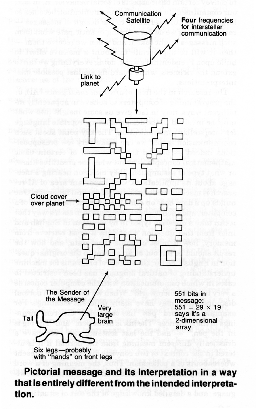 We have already suggested that pictorial information will not be sufficient for interstellar communication, and that a rich symbol system based language will also be required. However, before saying something more about such a language, we should say something about how much we can indeed hope to convey through a picture. A picture has been designed by Frank Drake* (*See "A Reminiscence of Project Ozma" by Frank Drake in COSMIC SEARCH, Jan. 1979.), for transmission to an extraterrestrial civilization. His pictorial message consisted of a string of 551 0's and 1's. It was assumed that the mathematical ability of the receiver would be such that he would notice that 551 was the product of the two primes 29 and 19. The fact that it could be broken down into a two-dimensional array but not into an array of any other dimension was meant to suggest to the receiver that in fact he display it two-dimensionally. Displaying it as 19 rows of 29 columns each would yield a far less meaningful pattern than that we have displayed in the figure as 29 rows of 19 bits each. Drake's intention was to design the picture in such a way that no intelligent species could fail to appreciate the message it contained. Let us now see how we might read off some of the information that has been packed into this small message. At the bottom left-hand corner, we can see the sketch of the creature which sent the message — and we may conclude with some confidence that it has a very large brain, six legs, and a tail. Somewhat above it we can see that the picture is cut almost in two, and it seems reasonable to infer that this suggests that there is a heavy cloud cover over the planet cutting the species off from outer space. We may then recognize above the cloud cover a communication satellite with beams radiating out from it. The beam back to the planet links the creatures with their satellite, while the four beams radiating upward either suggest that the communication is on four frequencies, or that communication on two frequencies is being spread out in all directions.
We have already suggested that pictorial information will not be sufficient for interstellar communication, and that a rich symbol system based language will also be required. However, before saying something more about such a language, we should say something about how much we can indeed hope to convey through a picture. A picture has been designed by Frank Drake* (*See "A Reminiscence of Project Ozma" by Frank Drake in COSMIC SEARCH, Jan. 1979.), for transmission to an extraterrestrial civilization. His pictorial message consisted of a string of 551 0's and 1's. It was assumed that the mathematical ability of the receiver would be such that he would notice that 551 was the product of the two primes 29 and 19. The fact that it could be broken down into a two-dimensional array but not into an array of any other dimension was meant to suggest to the receiver that in fact he display it two-dimensionally. Displaying it as 19 rows of 29 columns each would yield a far less meaningful pattern than that we have displayed in the figure as 29 rows of 19 bits each. Drake's intention was to design the picture in such a way that no intelligent species could fail to appreciate the message it contained. Let us now see how we might read off some of the information that has been packed into this small message. At the bottom left-hand corner, we can see the sketch of the creature which sent the message — and we may conclude with some confidence that it has a very large brain, six legs, and a tail. Somewhat above it we can see that the picture is cut almost in two, and it seems reasonable to infer that this suggests that there is a heavy cloud cover over the planet cutting the species off from outer space. We may then recognize above the cloud cover a communication satellite with beams radiating out from it. The beam back to the planet links the creatures with their satellite, while the four beams radiating upward either suggest that the communication is on four frequencies, or that communication on two frequencies is being spread out in all directions.
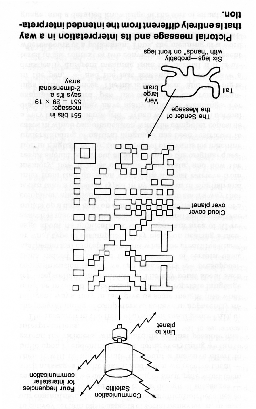 This last ambiguity indicates how difficult it is to be sure just which aspect of a picture is meant to convey what information. However, there is an even greater argument for the ambiguity of the message that a single picture may convey to an alien intelligence. This is that the picture we have been discussing is Drake's picture upside-down! If in fact you turn the picture the other way, you will see that the "communication satellite" turns into a biped — and this was meant to show that the intelligent species were somewhat man-like in shape. The "creature" — now at the top
right-hand corner of the picture — was in fact meant to be the symbolic representation of the carbon and oxygen atoms. Each is represented by a nucleus with two inner electrons, and then with four and six, respectively, electrons in the outer shell. The point of all this is that while there may be some chance of Drake's message being deciphered by an intelligence that expects any biped-like shape to be an intelligent being, it is very unlikely indeed to succeed with six-legged but large-brained creatures with tails. The challenge in defining interstellar communication, then, is to devise messages which cannot be so readily misconstrued.
This last ambiguity indicates how difficult it is to be sure just which aspect of a picture is meant to convey what information. However, there is an even greater argument for the ambiguity of the message that a single picture may convey to an alien intelligence. This is that the picture we have been discussing is Drake's picture upside-down! If in fact you turn the picture the other way, you will see that the "communication satellite" turns into a biped — and this was meant to show that the intelligent species were somewhat man-like in shape. The "creature" — now at the top
right-hand corner of the picture — was in fact meant to be the symbolic representation of the carbon and oxygen atoms. Each is represented by a nucleus with two inner electrons, and then with four and six, respectively, electrons in the outer shell. The point of all this is that while there may be some chance of Drake's message being deciphered by an intelligence that expects any biped-like shape to be an intelligent being, it is very unlikely indeed to succeed with six-legged but large-brained creatures with tails. The challenge in defining interstellar communication, then, is to devise messages which cannot be so readily misconstrued.
"No single message ... can reliably convey the meaning of a given set of symbols."
We have already mentioned one reasonable suggestion — that high resolution sequences of pictures — such as a cosmic zoom showing the neighborhood of the planet which is transmitting the message — can play a valuable role. Nonetheless, it seems that much information can only be conveyed when words are available to present hypotheses, or to emphasize which aspects of the picture are truly worthy of attention.
 The problem, then, is to establish a vocabulary of symbols and their meanings in which such communication can proceed. Let us suppose that the message consists of a string of pulses (as in Morse code) which may either follow immediately one upon the other, or may be separated by intervals of silence. Let us assume that the message is broken up into sentences — sequences of pulses separated by at most short pauses — with long pauses used to mark off one sentence from another. Suppose, then, that you were to receive the sequence of sentences indicated at the top of the accompanying diagram. The first four sentences—the sequence could be continued further as a safety factor — rapidly convey the idea of counting: 1, 2, 3, 4, . . . . With this, you may attain a reasonable degree of confidence that the message has told you that the code for a number is just the corresponding number of pulses separated by short pauses. Thus, when you turn to the next three "sentences" of the sequence you have some confidence in the interpretation that the messages take the form: 1 bleep 1 blip 2; 2 bleep 2 blip 4; and 3 bleep 2 blip 5. Your problem, then, reduces to interpreting "bleep" and "blip". Some reflection may lead you to the conclusion that "bleep" stands for "plus", while "blip" stands for "equals". However, this may not be true. It may be that our creatures write their mathematics backwards, and that these sentences should really be read from right to left rather from left to right, so that the correct interpretation of the three messages is: 2 minus 1 equals 1; 4 minus 2 equals 2; and 5 minus 2 equals 3. However, if the messages following were of the kind: 2 blap 2 blip 4, 2 blap 3 blip 6, 5 blap 3 blip 15, and so on, it would become far more likely that "blip" did indeed stand for "equals" rather than "minus", while "bleep" stands for "plus" and "blap" stands for "times".
The problem, then, is to establish a vocabulary of symbols and their meanings in which such communication can proceed. Let us suppose that the message consists of a string of pulses (as in Morse code) which may either follow immediately one upon the other, or may be separated by intervals of silence. Let us assume that the message is broken up into sentences — sequences of pulses separated by at most short pauses — with long pauses used to mark off one sentence from another. Suppose, then, that you were to receive the sequence of sentences indicated at the top of the accompanying diagram. The first four sentences—the sequence could be continued further as a safety factor — rapidly convey the idea of counting: 1, 2, 3, 4, . . . . With this, you may attain a reasonable degree of confidence that the message has told you that the code for a number is just the corresponding number of pulses separated by short pauses. Thus, when you turn to the next three "sentences" of the sequence you have some confidence in the interpretation that the messages take the form: 1 bleep 1 blip 2; 2 bleep 2 blip 4; and 3 bleep 2 blip 5. Your problem, then, reduces to interpreting "bleep" and "blip". Some reflection may lead you to the conclusion that "bleep" stands for "plus", while "blip" stands for "equals". However, this may not be true. It may be that our creatures write their mathematics backwards, and that these sentences should really be read from right to left rather from left to right, so that the correct interpretation of the three messages is: 2 minus 1 equals 1; 4 minus 2 equals 2; and 5 minus 2 equals 3. However, if the messages following were of the kind: 2 blap 2 blip 4, 2 blap 3 blip 6, 5 blap 3 blip 15, and so on, it would become far more likely that "blip" did indeed stand for "equals" rather than "minus", while "bleep" stands for "plus" and "blap" stands for "times".
The moral is clear. No single message or small set of messages can reliably convey the meaning of a given set of symbols. However, if we send enough examples of how symbols are to be used, using different symbols in different contexts, then it becomes more and more likely that the web of usage will trap the symbols in a single meaning. There has been surprisingly little work on the development of a string of messages which will build up an unambiguous interpretation for a sufficiently rich set of symbols and words. The only example that I know of that has been worked out in immense detail is contained in the book "LINCOS" by Hans Freudenthal, a Dutch mathematician, which was published in 1960. However, I know of no attempt to build misinterpretations of the system of the kind provided in the previous figures. In any case, Freudenthal's achievement remains impressive, for he was able to build a vocabulary through sequences of examples of the kind shown in Figure 2 [i.e., Frank Drake's picture (above on the right in rotated and non-rotated views)] which was rich enough to express basic concepts of Newtonian physics and of relativity theory, as well as to express the concept of truth and of falsehood, and to convey certain basic aspects of social behavior. If, in fact, our commitment to interstellar communication becomes so large that we turn seriously to the design of messages — rather than, as we do here, trying to anticipate what form such messages might take if and when we receive them — then it will be appropriate to mount a massive effort to build upon Freudenthal's work, doing everything we can to extend the richness, while guarding against possible misinterpretations.
"The trouble with pictures is that they are too literal to communicate general truths."
The research in the field of artificial intelligence (AI), or the programming of computers to behave in apparently intelligent ways, may in fact give us some insight into what must be involved in the design of an appropriate language for interstellar communication. The key point about such communication is that we can make very few presuppositions indeed — beyond the possession of certain basic mathematical concepts — about what the creatures know, or what type of assumptions they make on hearing a message about its implications. One important area of AI research is machine understanding of natural language. One builds up a data base on some topic within the memory of a computer, and then wishes to program it in such a way that it can take a question typed in by a human in English and infer from that question what data it must retrieve from memory, how it must combine those data, and how the result should be put out as an answer to the original question in English. So far, the success of programs for machine understanding of natural language has been restricted to cases in which communication with the computer concerns a very limited "microworld". When we use words in normal discourse, they may have many different meanings. For example, the word "pen" has completely different meanings in the sentences "The ink is in the pen," and "The pig is in the pen," — and the last sentence can even have a drastically different meaning from the normal if it is uttered in the context of two convicts discussing the present whereabouts of a policeman. Thus, the meaning of a word may be very hard to infer unless one has a detailed knowledge of the syntax or grammatical structure of the language, and a detailed knowledge of the sort of situation — in other words the "microworld" — that the sentence is about. A computer program for understanding English sentences only works if it is provided with a full specification of grammatical structure and a full specification of the very limited world to which the sentences may refer. We may expect, then, that our interstellar communication must start by spelling out in inordinate detail the conventions for structuring the strings of our language, and the topics about which we will communicate.
However, rather than try to get away with the type of brief ambiguous expressions that work well in normal human discourse, we will probably build a language which — while using high-level constructs to refer to earlier discourse so as to keep the length of individual sentences within bounds — will be structured to reduce ambiguity. One may think of a mixture of the language of legal documents and the language of algebra to get an approximation to what such a language would look like.
One of the dominant themes in current research on linguistics — the structure of language — concerns the search for a "universal grammar". However, in the context of our present topic, this search for universal grammar is very parochial indeed. It is not a search for a grammar which applies to all languages throughout the universe — rather it looks for commonalities amongst all human languages, in the hope that this will give us some insights into the structure of the human brain which all of us share due to our common evolutionary heritage. Thus, unfortunately, it is not clear that the science of linguistics as it is currently developed has too much to offer us. Intriguingly, we must look back to the 16th and 17th Century for descriptions of mythical voyages to the Moon and other planets for attempts to build a language which is indeed truly universal. This search for a so-called "universal character" was centered on the idea that one could symbolize an object or a property in such a way that the symbol contained within its structure all that one needed to know about that which was symbolized. Fortunately, or unfortunately, we now know so much more about the objects of our world — and infer much about the objects of other worlds — that we cannot believe in the existence of such symbols. If we wish to keep our symbols of manageable size, then they must in some sense be short and arbitrary — as many of the words of the English language indeed are — but able to refer to bodies of accumulated knowledge stored elsewhere in our dictionaries or encyclopedias or libraries. It is the intermingled development of such symbols together with the information to which they refer that we must now turn.
Structuring the Message
Suppose, then, that we — or whoever is creating the interstellar message — have designed a language which appears to be sufficiently universal that it can be comprehended by an intelligence which has some form of language and some mathematical ability of its own. Suppose, too, that we have designed a sequence of statements which make the items of the language almost impossible to misinterpret. It might seem that the appropriate way to start a conversation going, then, would be to provide the sequence of statements which serves to teach the receiver this new language, and then — having established the language — use it to provide instructions upon how to send a reply, and then give the questions to which a reply is sought. However, a little reflection shows that this is not a good way to proceed. While we cannot guarantee that a communicating intelligence would use the following strategy, we now present a strategy which does seem likely.
The first consideration to bear in mind is that the recipient or receiver may only sample the message for a short period of time. If he were to come upon the message long after the transmission of the basic vocabulary, there would be little chance of comprehension. The other point is that even with optimistic assumptions the round-trip time for a communication may be 200 years and delays of this kind suggest that a strategy of sending a question and then sitting back while waiting for a reply is ill conceived.
Instead, then, we suggest the following. Approximately every five minutes a short message is sent of so regular a structure that anyone hearing it will be convinced with high probability that they are listening to the product of some intelligence, rather than some natural phenomenon. The message might be a "number beacon" like that whose initial segment is given in Figure 2 [see Frank Drake's picture above (in rotated and non-rotated views)] which is sufficient to establish not only the intelligence of the transmitter, but also to establish the basic number system which will be used.

Let us call this "number beacon" Track 0: exactly the same message will be transmitted on Track 0 for the first of every 5 minutes, as shown in Figure 3 [centered above]. Let us call the second segment of each 5 minutes Track 1. Track 1 is to be devoted to basic vocabulary, and would build up the knowledge of a language such as LINCOS on which further communications are based. It might be that a month would suffice to build up the basic vocabulary of the interstellar language, and so each segment on Track 1 would start with a number A which indicates how many more segments on Track 1 are required to complete the basic vocabulary lesson. We would quickly notice that immediately following the Track 0 standard message came a number, and that this number decreased by 1 every time. It would thus be reasonable to infer that some countdown was taking place, and that the basic vocabulary lesson would be reinitiated as soon as the count passed 0. This would thus give us the confidence to hold on until the Track 1 cycle started again, knowing that we could then proceed to gain our basic vocabulary. Presumably, the Track 1 cycle would include a general description of the other features of the message, and instructions on how to acquire even further information.
Track 2 would contain the basic encyclopedia — it might have something like a 10 or even 100-year cycle time — but given the time-scale of the communication this is not an unreasonable time to wait. During this period, we would gain an appreciation of the type of intelligence with which we were communicating, and would learn much about their sciences and culture. We might think, then, of Track 2 as being the transmission of the Encyclopedia Galactica, with a complete transmission every hundred years, say, with perhaps a new edition coming out each century!
The remainder of each 5 minutes would be reserved for the transmittal of on-going information (Track 3), the equivalent of sending the journals of the culture across the galactic space, but with questions and requests for comparative data interspersed with the account of the latest discoveries of the transmitter.
Within a century, then—and possibly much sooner—we would have learned enough to initiate transmission of our own response.
It is perhaps worth saying something more about the nature of the encyclopedia. An encyclopedia as we normally know it has entries arranged in alphabetical order. To find information in the encyclopedia one must have firstly the idea that the information is contained within the encyclopedia and secondly a number of words with which to index an item — these words can then be used to provide alphabetical addresses to get access to possibly relevant entries in the encyclopedia. However, if we are to receive an Encyclopedia Galactica neither of these conditions hold. We do not know what is stored in the Encyclopedia, and we often lack the words which will give us access to the material even if it is there. It does not seem unreasonable to suggest, then, that the Encyclopedia should take the form not of the equivalent of written volumes, but rather the form of elaborate computer programs which will hold a vast amount of information but also provide highly structured means for getting access to the data on the basis of many tentatively formulated questions. Perhaps, then, it is not too fanciful to imagine that early stages of the Encyclopedic information would include instructions on how to build a computer, and how to program it, so that it would be able to serve as an active repository for the Encyclopedia Galactica. Going even further, one may imagine that the computer will be constructed in such a way that eventually it can simply program itself on the basis of the incoming interstellar message, without any further direct intervention on the basis of the recipient. The computer need not only contain dialog enquiry programs to give us access to the sort of information that a written encyclopedia would contain, but could also contain simulation programs. It might even contain world models of a kind far transcending those currently studied by the Club of Rome, and it would be by the studying of those models under varying input conditions as tested on the computer that we would be able to make projections about the fate of mankind under varying types of decisions on the form of international relations. Of course, one might become very paranoid, and imagine that the computer we are building is the artificial intelligence which will succeed us as the next highest form of intelligence on Earth (recall the novel "A for Andromeda"!).
"One of the most important aspects of language is that it frees us from the here and now."
Another intriguing question raised by the proper structuring of such a message is the question of how intelligent we really are — even when we join our minds together in symbiosis with sophisticated computers. To take a homely example: a number of scientists have discovered that chimpanzees can indeed be taught a simple 'language', and construct quite complicated sentences by putting symbols they are taught together in novel ways. In fact, we have not yet exhausted the complexity of what a chimp can learn, and it may well be that they can come to greatly transcend their current apparent limitations. However, there is little evidence yet that chimpanzees can create a language nearly as complex as that which they can learn — though, again, it may take many generations of training chimpanzees and then letting them live together with young chimpanzees before we can explore the justice of this claim. Have we, then, reached a 'regenerative stage' when — at least in symbiosis with our machines — we are capable of understanding anything which any intelligence can understand, or are there new levels which are blocked to us, and which we may be taught in a passive way as the chimpanzees are now taught, but in which we can never aspire to be creative?
In any case, if we are going to receive communications from a civilization which is hundreds of thousands of years old, we may well expect that they will have notions which far transcend anything which we can now imagine. To many readers, the idea that the interstellar message should provide instructions on how to assemble a computer which can then answer many questions in a flexible way seems to come right out the the pages of science fiction. Yet, in fact, we are within the first 50 years of the existence of general-purpose computers on our planet. In other words, such an idea may seem incredibly old-fashioned — perhaps even lost in the mists of primeval history—to the transmitters. If communication is established, we may be in for a lot of surprises.
The Nature of the Conversation
What does one say in a dialog in which each question must wait 200 years for an answer, and the "conversation" may extend over millenia? Are we to imagine that dialog must fail, as we become passively overwhelmed by the flood of information which "gives us all the answers"?
To answer these questions we must realize that we are in fact at this very time receiving messages from intelligent civilizations, messages transmitted hundreds or even thousands of years ago. By these messages, I refer to such documents as the American Constitution, the writings of Newton or Euclid, the corpus of Greek philosophy, and the Bible. What is important about these examples is that they do not, in fact, "give us all the answers". Nonetheless, they are rich mines of information, and provide a basis for an on-going process of interpretation — just think of the disciplines of constitutional law, philosophy, and theology.
What this means is that knowledge is not simply a pile of pieces of data, to which one may turn for the answer to any given question. Rather, it provides a source of ideas, with which we must struggle in determining what to do in a particular situation.
To take one example: We have suggested that one of the most valuable things that we can learn from the Encyclopedia Galactica is a route to world stability. Yet what if we receive a message from an alien intelligence telling us that they have found that the key to social harmony is for adults to live together in groups of 12 — with four of each sex! When we turn from physics to sociology, we may find that much of the information is conditioned upon a biology with a completely different evolutionary history to our own. Trying to understand why groups with four of each of the three sexes help these creatures may give us insight into new ways of organizing our own society. But it is in no way a strategy which can be plugged in for any human society.
"What does one say in a dialog in which each question must wait 200 years for an answer . . ."
Bearing this in mind, the leisurely pace of interstellar communication becomes in fact appropriate — it gives us time to assimilate the messages that we receive, and accommodate to them, providing grist for our own theories which we will use to guide our own actions. We can expect, then, that it will require the wisdom of many humans to transform the interstellar message into prescriptions for courses of action. In the case of purely physical projects — such as the description of a new energy source — the implementation of suggestions contained in the interstellar message may be relatively direct. But, as we have already seen, the use of sociological insights may require a drastic transformation. It is perhaps to be expected that, in the nature of humankind, many 'false prophets' will arise once we receive such messages, who will forcefully argue for the adoption of various social structures long before they have been transmuted into a form adapted to human needs and, history. But the give and take between fashionable cult and accumulated wisdom has always been part of the human condition, and there is no reason to expect that to change, no matter how much of the galactic wisdom should one day come to be ours.
 Michael A. Arbib is Professor of Computer and Information Science and Director of the Center for Systems Neuroscience at the University of Massachusetts, Amherst. Born in 1940, he received a Bachelor's degree from the University of Sydney, Australia, in 1961 and a Doctor's degree from the Massachusetts Institute of Technology in 1963.
Michael A. Arbib is Professor of Computer and Information Science and Director of the Center for Systems Neuroscience at the University of Massachusetts, Amherst. Born in 1940, he received a Bachelor's degree from the University of Sydney, Australia, in 1961 and a Doctor's degree from the Massachusetts Institute of Technology in 1963.
Arbib's primary research interests lie in the mathematical study of computation and control on the one hand, and in the study of brain theory and artificial intelligence on the other hand. However, he has maintained an interest in the problems posed by interstellar communication ever since taking part in a series of lectures given at NASA's Ames Research Center in Moffett Field, California in the summer of 1970. The present article is the revised text of a lecture given as part of a lecture series on "Our Galactic Heritage" at San Jose State University and San Francisco City College in May, 1976. Readers wishing an elementary introduction to some of the concepts of computers and artificial intelligence discussed in the present paper may consult Arbib's book "Computers and the Cybernetic Society" (Academic Press, 1977).
|
|
The SEnTInel (SETI News)
By: Robert S. Dixon
[Article in magazine started on page 26]
- Detection of Planets near Distant Stars
- Mars Life Search Inconclusive
- Chemotons – The Fundamental Particles of Life
- Ionizing Radiation May Have Started Life
- Computer Program Exhibits Life-like Behavior
- Large Space Antenna Planned
- Signal-seeking System to be Designed
- SETI Hearings in Washington
Detection of Planets near Distant Stars
Current optical telescopes and photographic techniques probably are not powerful enough to definitely establish the existence of planets outside our own solar system, according to Professor George Gatewood of the University of Pittsburgh.* (* Congress of the International Astronautical Federation, Dubrovnik, Yugoslavia, October 1978) He specializes in astrometry (the measurement of star positions to extreme accuracy) and has been searching for tiny back-and-forth motions of stars that would reveal the existence of orbiting planets. The planets themselves are too dim to be visible directly, but since planets and their parent star revolve around their common center of mass (rather than around the center of the star as is commonly believed), planetary existence can be detected by the rhythmic motion of the star during each planetary revolution. Since stars are much larger than planets, their common center of mass is much closer to the star then to the
planet, typically lying somewhere near the surface of the star. This means that the back-and-forth motion is only about twice as big as the star itself.
The fundamental limitation thus far in finding these tiny motions has been the irregularities in the Earth's atmosphere. Since the atmosphere is not perfectly uniform and stationary, stars appear to jiggle around a little bit (the same effect also causes twinkling). This makes it difficult to measure their positions accurately. Gatewood is now developing a new technique that will overcome a large part of this problem. He has discovered that all the stars in any small area of sky jiggle together, like synchronized dancers. By continuously tracking the positions of several other nearby stars in addition to the one he suspects of having planets, Gatewood is able to measure the relative position of the suspect star with respect to the others, almost independently of their common jiggling. This technique increases the accuracy of the measured position to the point that planets the size of Saturn could be detected up to 15 light years away.
The next limitation is the imprecision of existing optical telescopes. Gatewood points out that telescopes have never needed to be any better than they are now, since the atmosphere always limited their ultimate accuracy. Using Gatewood's technique, however, the telescope becomes the limiting factor. Gatewood proposes to overcome this limitation by building a telescope specifically designed for this purpose. The telescope itself would be completely stationary, with starlight being reflected into it by a moveable flat mirror. This would eliminate the slight elastic bending that occurs in the large glass lenses of
other telescopes as they tilt to look at various angles in the sky. The telescope would also be in a vacuum, to eliminate the refractive effects of air between the lenses. Such a telescope would double the range at which planets could be detected, enabling Saturn-size planets to be found at 30 light years.
The ultimate solution proposed by Gatewood is to put the entire telescope in space. This would eliminate the effects of the atmosphere and gravity completely, and allow planets as small as the Earth itself to be found at 30 light years. There are about 200 stars within this range, and investigation of all of them would provide a clear indication of how common planets (and by inference, life forms) are in the universe.
Mars Life Search Inconclusive
A conference about the planet Mars was held recently at the California Institute of Technology in Pasadena, California. About 500 scientists from a dozen different countries participated and presented the results of their research programs. It seems clear that water is present on Mars in the form of permafrost and snow, but the Viking lander data about life forms is still inconclusive. Dr. Harold Klein of the NASA Ames Research Center at Mountainview, California, said that the most likely meaning of the Viking data is that no life forms were found, but that their absence is not yet proven.
Chemotons – The Fundamental Particles of Life
The random evolution of highly complex organic molecules does not lead directly to life forms. The missing ingredient is the overall organization of the molecular complex in such a way as to produce life-like characteristics such as individuality, self-regulation and control, growth, proliferation, heredity, adaptivity, and the ability to evolve into more complex systems. So says T. Ganti, of the University of Eotvos Lorand in Budapest, Hungary.* (*Congress of the International Astronautical Federation, Dubrovnik, Yugoslavia, October 1978) He has named the smallest particle of life having these characteristics to be the Chemoton. This is analogous to the way that an atom is the smallest particle having the properties of an element, and a molecule is the smallest particle having the properties of a compound.
Ganti states that a Chemoton consists of three components, each of which is itself a complex organic system, each of which is capable of reproducing itself, and each of which is believed to already exist in nature, and be capable of spontaneous formation by random chemical evolution.
The first component of a Chemoton is a chemical system which reacts with adjacent raw materials to produce additional quantities of itself.
The second component is a chemical system which reacts with adjacent raw materials to produce higher and higher polymers (more complex versions) of itself. The third component is a chemical system whose physical characteristics are such that it always
exists as a thin membrane. Chemical membranes of this type generally exist as spheres, and Ganti says they have been observed to spontaneously divide into two identical spheres.
The mechanism by which these three components could be fused to form a Chemoton is not yet known, but putting that problem aside for the moment, Ganti has analyzed the behavior of the Chemoton itself. He has used a computer to solve the system of
nonlinear differential equations that describes the behavior of a Chemoton, and finds that it does in fact possess all the characteristics of life described above.
Ganti is continuing his research into the formation of the three necessary components and into their fusion. He states that his research, if successful, will demonstrate that the spontaneous formation of living systems is neither accidental nor miraculous, but is inevitable wherever and whenever suitable conditions exist.
Ionizing Radiation May Have Started Life
The role of ionizing radiation (gamma rays, electron or proton bombardment) in the formation of elementary life may have been underestimated, say the husband and wife team of Ivan and Zorica Draganic, from the Boris Kidric Institute of Nuclear Sciences in Vinca, Yugoslavia.* (*Congress of the International Astronautical Federation, Dubrovnik, Yugoslavia, October 1978) Most investigators consider ultraviolet light to be the source of energy that gradually created more and more complex organic molecules from the elementary molecules present on primordial Earth.
The Draganics point out that ionizing radiation was more intense and widespread in the past than it is today. Examples of this are the radiation from supernovae that have probably occurred near the Earth several times during its history, and the occurrence of natural nuclear reactors. Uranium 235 (the kind used in reactors) was much more abundant in the early history of the Earth than it is now, and natural sedimentation processes are known to concentrate uranium into deposits. A natural deposit containing only a 5% concentration of uranium need only be 3 1/2 meters in diameter to be a critical mass. This would start a chain reaction producing heat and ionizing radiation, in exactly the same way that man-made atomic reactors produce energy and radiation. Such naturally-occurring nuclear reactors are known to have occurred, since the remnant of one was recently found in Gabon, Africa.
The Draganics believe that natural reactors were probably widespread in the early history of Earth. Since the energy available for the synthesis of organic molecules was much larger in the vicinity of these reactors than that generally available from ultraviolet light and other sources, the reactors may have been the parents of the first life-like molecules.
Computer Program Exhibits Life-Like Behavior
It is possible to create computer programs that exhibit life-like characteristics such as self-reproduction, random evolution (mutation) and purposeful evolution (self-modification toward a desired capability). Michael Zeidler, a computer consultant from Milwaukee, Wisconsin, has developed a method of creating such a program.* (*"Digital Design," August 1978) His purpose in doing so was to reduce the amount of work required to program complicated problems on computers.
Zeidler starts out with two separate programs in the same computer, each of each is capable of calculating only a crude approximation of the required answer. Each program can also modify the other program. In actual operation, one program starts out, obtains a crude result, and modifies the other program in such a way as to improve it. Then the second (now improved)
program runs, obtains a better solution, and modifies the first program. The two programs continue to take turns solving the problem and modifying each other in a constructive way, so that ultimately the exact answer is obtained.
The important thing is not the answer, but the final program that calculates the answer. That program can then be saved and used to solve similar problems elsewhere. Zeidler points out that the evolution and cooperation among his programs is similar to that of life forms. It is an easy matter for a computer program to make one or more copies of itself, analogously to the reproductive process of life. Mutation can occur if the copies are not exactly the same as the originals, which might occur either accidentally or purposefully.
Zeidler speculates that unconstrained programs capable of self-evolution and mutation might ultimately exhibit unpredictable and perhaps intelligent (or even dangerous) behavior. Since computers are so fast, evolution could occur faster than human observers could keep track of it. These are interesting notions, telling us that the line dividing artificial from natural intelligence is getting thinner, and that if we ever find intelligence elsewhere in the universe, it may not be obvious which kind it is.
Large SpaceAntenna Planned
The U.S. Air Force is making plans to launch a 183 meter diameter antenna into Earth orbit by 1985.* (*"Electronic Warfare/Defense Electronics," October, 1978) The collapsible antenna structure would be carried aloft by the Space Shuttle in two pieces. Each piece would be expanded to full size while in space, and the two would then be joined to create the full 183 meter structure. The Air Force plans to use the antenna as a radar to track ships, aircraft, missles and other vehicles down on the Earth. The radar will use a 50 kilowatt transmitter and operate at a frequency of about 1.2 gigahertz. The antenna is not the conventional parabolic dish type, but consists of thousands of small wire antennas (called dipoles) fastened onto a flat, light-weight grid structure. This type of antenna (known as a phased array) is capable of steering its beam around very rapidly, without actually moving the entire structure at all.
A second purpose of the antenna is to provide experience in constructing and operating large structures in space. Even larger structures are planned for the future, such as a huge solar power satellite. The implication of this project for SETI is that the technology will soon be at hand to construct large antennas in space, suitable for all purposes, including SETI.
Signal-seeking System to be Designed
Each summer, a number of special research and design projects are carried out at many American universities, in cooperation with various military and civilian research organizations. Each project is on a different topic, and about 20 university
scientists from all across the country are chosen to participate in each project. The purpose of these projects is to
provide experience and training for the participants, and to provide useful results to the host universities and cooperating research organizations. Project Cyclops, held in 1971 by Stanford University and the NASA Ames Research Center is perhaps the most well-known example of these projects to readers of COSMIC SEARCH.
This summer, the University of Santa Clara, in cooperation with the NASA-Ames Research Center, is sponsoring a project to design a system capable of finding the few meaningful data points that may exist within the millions of data points that will be gathered every second by the SETI receivers now being planned. The project will be directed by Professor Timothy Healy, of the Department of Electrical Engineering and Computer Science at the University of Santa Clara, California. If the design team is successful, their system will also find wide usefulness in other areas such as earthquake prediction, location of earth resources from satellite data, and medical diagnosis.
The problem is very difficult, since the system has no way of knowing exactly what to look for. An analogy is to imagine yourself searching for an unknown man-made object that might or might not be present somewhere in a large jungle, and you have only one second to complete the entire search. If you could see the object, you would probably instinctively recognize it as
being man-made, but you don't have enough time to search the whole jungle for it. Thus you are forced to construct a high speed machine (a computer) to do it for you. The only problem is, how does the machine distinguish between a man-made object
and a tree or an elephant or a rock? This is the central problem to be solved by the design team. COSMIC SEARCH wishes them success.
SETI Hearings in Washington
The first Congressional Hearings ever held on the subject of the Search for Extraterrestrial Intelligence took place in Washington September 19-20, 1978. Seven scientists and engineers presented their views to the Subcommittee on Space Science and Applications of the House Science and Technology Committee.
Subcommittee Chairman Don Fuqua (D-Fla.) introduced the hearings by noting that the House and Senate authorization committees that deal with space science and technology had both approved NASA's request for $2 million to begin an initial SETI program, but that the Appropriations Committees of both Houses had cut this to zero in conference. Fuqua said that, while the prospects for successful search may be remote, either a positive or negative outcome could have significant implications for our society.
All witnesses agreed that the search was a legitimate activity, though most believed the likelihood of success was small, and that the level of effort and funding devoted to it should be modest. Several argued that SETI should not be seen as a separate project, but as part of a broader research effort aimed at understanding the evolution and frequency of life in the universe. Some suggested that detection, if it occurred, was likely to be a serendipitous spin-off from normal scientific research. None of the witnesses speculated extensively about the consequences of detection and contact.
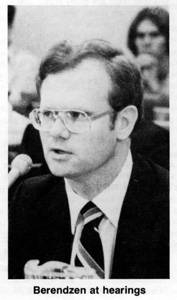 The leadoff witness was Dr. Richard Berendzen, Provost of the American University. His remarks were presented in the March 1979 COSMIC SEARCH.
The leadoff witness was Dr. Richard Berendzen, Provost of the American University. His remarks were presented in the March 1979 COSMIC SEARCH.
Berendzen was followed by Professor Philip Morrison of the Massachusetts Institute of Technology, who titled his presentation "Twenty Years After." His remarks are the same as appeared in the January 1979 issue of COSMIC SEARCH.
 The third witness was Dr. Noel Hinners, NASA's Associate administrator for Space Science. He described NASA's proposed SETI program as an imaginative, relatively low-cost gamble that could provide immense rewards if successful, and an excellent
return of science data and technological development regardless of the SETI aspect. We can not judge whether or not a SETI search will be successful; we have not yet made a meaningful try. The transmitters necessary to be detected require little
or no advance from our relatively young technology. (Hinners made clear that he was not proposing that we broadcast). There may be civilizations in our galaxy that reached our state of development billions of years ago. By looking for other civilizations, we are in effect trying to look into our own future.
The third witness was Dr. Noel Hinners, NASA's Associate administrator for Space Science. He described NASA's proposed SETI program as an imaginative, relatively low-cost gamble that could provide immense rewards if successful, and an excellent
return of science data and technological development regardless of the SETI aspect. We can not judge whether or not a SETI search will be successful; we have not yet made a meaningful try. The transmitters necessary to be detected require little
or no advance from our relatively young technology. (Hinners made clear that he was not proposing that we broadcast). There may be civilizations in our galaxy that reached our state of development billions of years ago. By looking for other civilizations, we are in effect trying to look into our own future.
Hinners described NASA's two-tier strategy: the JPL all-sky survey, and the NASA Ames targeted search. NASA considers it better to make a broad radio survey first on account of increasing pollution of the airwaves. The microprocessor revolution makes possible the million-channel analyzers that are at the heart of both programs. Hinners emphasized that the radio SETI search is only one approach to the broader question of understanding the origin of life in the universe.
The afternoon session opened with the testimony of Dr. George Pimentel, Deputy Director of the National Science Foundation, who said he was speaking as an individual. In Pimentel's view, the relatively small-scale SETI experiments being conducted
today are proper efforts. They consume only a minute portion of the time and resources available for scientific research, and have a rightful place in scientific inquiry.
Pimentel was followed by Dr. A. G. W. Cameron, Chairman of the Space Sciences Board of the National Academy of Sciences.
Cameron said SETI is one important component of a larger and extremely fundamental question: What is the role of biology in the universe? To the degree that we ask about intelligence, we also involve the social sciences. Whether a search shows that we have lots of neighbors or that we are alone, the answer will be very important to the human race and its ultimate development. If humans prove to be a long-lived species, their ultimate destiny will be quite different in these two cases, but it would be premature to judge that one destiny would be better than another.
Cameron concluded his remarks by stating that SETI activities should have a place among NASA scientific programs.
The first witness on the second day was Dr. David Heeschen, former Director of the National Radio Astronomy Observatory (NRAO), where several SETI searches have been conducted. Heeschen described the development of ideas about intelligent life beyond the Earth as one of the major intellectual and philosophical events of this century. The searches rank among the most important developments of recent times; Heeschen was proud that NRAO has been involved in them. At NRAO, he noted, such searches have never taken more than 1 percent of total observing time in a given year. In conclusion Heeschen said that we
should support as much as we can afford and as the most able people are willing to undertake.
The last witness was Bernard Oliver, Vice-President for Research and Development of the Hewlett-Packard Corporation, and Co-Director of the NASA sponsored Project Cyclops study in 1971. Oliver's comments are presented in full elsewhere in this
issue of COSMIC SEARCH. An editorial by Oliver on SETI-funding appeared in the March 1979 issue of COSMIC SEARCH.
Questions and Answers
Congressman Lloyd (D-Calif.), apparently referring to the Golden Fleece Award Sen. Proxmire gave to NASA's proposed SETI program, asked how SETI could avoid political cheap shots. Berendzen said that the answer is education; Morrison that
SETI would be well received by the public; Hinners that SETI needs more exposure in the appropriations committees. Lloyd commented that supporters of SETI must bring it into the public arena so that politicians can help them.
Congressman Winn (R-Kan.) asked why the Space Science Board has not taken a position on SETI. Cameron replied that NASA has not asked the Board for an opinion. Oliver noted that the 1958 Space Act included the search for life as part of NASA's charter.
The Subcommittee staff deliberately avoided publicizing the hearings in advance out of fear of an influx of "fringe types." As a result, public attendance was sparse, and although only a few media representatives came to the opening session, there was some press coverage (see, for example, the WASHINGTON POST editorial reprinted elsewhere in this issue of COSMIC SEARCH). The absence of such well-known SETI personalities as Carl Sagan and Frank Drake, and the lack of witnesses from the social sciences and the humanities was noteworthy. Congressional attendance was thin, partly because the hearings were concurrent with the signing of treaties by President Sadat and Prime Minister Begin.
(An 89 page report on the hearings entitled "Extraterrestrial Intelligence Research" (No. 97) is available from the U.S. Government Printing Office.)
SETI Puzzle (A Cryptographic Exercise)
Suppose that the message below were received at one of our radio observatories.* (*Contributed by Timothy Healy. See page 41 for hint.) This small portion might be a "signature page". Can you decide who sent the message, when it was
sent and where it came from?
[From page 41: SETI Puzzle (page 30) Hint: If you can't think of how to start, you might look at Chapter 30 of I.S. Shklovsky and C. Sagan, Intelligent Life in the Universe, Holden Day, Inc., 1966.
Miscellaneous
Heaven and earth are large, yet in the whole of space they are but as a small grain of rice. It is as if the whole of empty space were a tree, and heaven and earth were one of its fruits. Empty space is like a kingdom, and heaven and earth no more than a single individual person in that kingdom. Upon one tree there are many fruits, and in one kingdom many people. How unreasonable it would be to suppose that besides the heaven and earth which we can see, there are no other heavens and no other earths?
Teng Mu, 13th century philosopher (translated by Joseph Needham)
"Success in any venture is just the intelligent application of previous failure." Maxie Anderson of the Double Eagle II, the first balloon to float from the United States to Europe.
"It ain't so much the things we don't know that get us in trouble. It's the things we know that ain't so."
Artemus Ward (1834-1867)* (*Contributed by Robert Morton)
The soul of man was made to walk the skies;
Delightful outlet of her prison here!
There, disencumbered from her chains, the ties
of toys terrestrial, she can rove at large...
Edward Young
"Night Thought"
1745
"For thousands of years, people have sought their future in the starry sky. Now this old superstition has at last come true, for our destinies do indeed depend on celestial bodies — those that we have created ourselves."
Arthur C. Clarke.
|
|
We Wait and Wonder
By: John Kraus
[Article in magazine started on page 31]
Are we alone or are there other beings out there across the immense reaches of space who might be sending out radio signals we could hear? This question has long been a tantalizing one, and in recent years, with the construction of large radio telescopes, we now have the ability to try and find out.
Giuseppe Cocconi and Philip Morrison proposed in 1959 that a search should be made and the following year Frank Drake did just that in his famous Project Ozma but with negative results. Then in 1967 at the Cambridge University, England, radio observatory, Jocelyn Bell did discover strange pulsing signals from the sky which strongly suggested an extraterrestrial intelligent origin. However, these turned out to be emissions from a new kind of celestial object called a pulsar. (For details of these events see the January 1979 issue of COSMIC SEARCH).
Over the years many other searches have been made at many different radio observatories with negative results. But probably no search has been carried out more continuously for a longer time than the one started at the Ohio State-Ohio Wesleyan radio observatory in 1973. In this survey, which is still continuing, has any signal been detected which is suggestive of an extraterrestrial intelligent origin? Yes, and thereon hangs this tale.
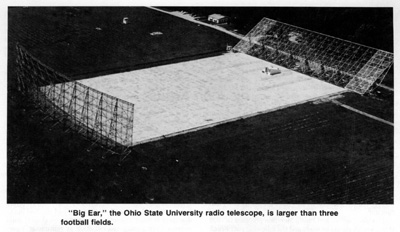 With National Science Foundation support and Ohio State University students doing the work, we began the construction of a large radio telescope near Delaware, Ohio, in 1956. Progress was slow but by 1963 the telescope was sufficiently far along to begin preliminary observations. Two years later we started a systematic survey of the entire sky accessible to our telescope that continued for 8 years resulting in our mapping and cataloging some 20,000 radio sources in the largest most complete survey anyone had made. Radio maps were a rather new thing at the time and because radio wavelengths are so much longer than
light the radio sky is quite different from the visual one.
With National Science Foundation support and Ohio State University students doing the work, we began the construction of a large radio telescope near Delaware, Ohio, in 1956. Progress was slow but by 1963 the telescope was sufficiently far along to begin preliminary observations. Two years later we started a systematic survey of the entire sky accessible to our telescope that continued for 8 years resulting in our mapping and cataloging some 20,000 radio sources in the largest most complete survey anyone had made. Radio maps were a rather new thing at the time and because radio wavelengths are so much longer than
light the radio sky is quite different from the visual one.
In 1964 when Robert S. "Bob" Dixon came to the Ohio State University as one of my graduate students, I started him on a mapping project which carried over into the big 8 year survey. One of Bob's early contributions was the development of a method for using antenna pattern fitting with a computer to produce cleaner, more reliable maps. This method, which Bob described in his doctoral dissertation in 1968, has become standard for improving the quality of telescope outputs.
In 1972 outside support for our mapping project was abruptly terminated due to a shift in funding priorities and we found ourselves in a strange situation. Our telescope was not the world's largest but there were very few larger. It also had one of the most sensitive 21 centimeter receivers in operation anywhere. Our big survey had resulted in the discovery of many objects belonging to a new class of radio sources having enhanced radiation at centimeter wavelengths and some of these—OH471 and OQ172—proved to be the most distant and most powerful sources ever found. Thus, we had a telescope of great capability but with no funds to do anything on a large scale. Would it be possible to do something at a very modest level?
Some years earlier, as a master's thesis project, William D. "Bill" Brundage* (*Now Chief Engineer of the Green Bank 91 meter telescope.) had built an 8-channel receiver for studying the hydrogen in the Andromeda galaxy. Bob Dixon now suggested that we utilize Bill's receiver to begin a "waterhole" search for narrow-band signals of extraterrestrial intelligent origin. His reasoning might be put this way: If we could discover what is out there essentially to the "edge" of the universe maybe our telescope could be useful in finding who might be out there. Bob didn't have to work very hard to persuade me, as the observatory director, to go along with the idea. So Bill's receiver was reconnected and by late 1973 we began our search on a routine basis. (More details of the above story are given in my book "Big Ear").
 Within a couple of years we had added a 50-channel receiver to supplement the old 8-channel one, and a dual-horn feed system, giving us two observations of a source on each transit instead of one and significantly improving the quality of the records. Bob Dixon had also connected a big computer on-line to process the data and print the output of all 50 channels in a simple-to-read format. Even though the observatory funding was now close to zero we were running the survey on an around-the-clock basis and continually making improvements in the equipment, in the data processing and in its analysis, but only because we had, in the meantime, acquired a lot of unpaid help. Many undergraduate engineering students designed and built new components for course credit, obtaining valuable practical experience to supplement the theory of the classroom. Then Richard Arnold volunteered to work an evening or so a week on equipment. Dick received his doctorate in electrical engineering from Washington University of St. Louis and was employed by the Bell Telephone Laboratories of Columbus. Jerry Ehman also volunteered to put in time on weekends. During the week he taught at Franklin University in Columbus. Jerry had been involved in our big sky survey some years earlier but had to leave when our funds were cut off. Now we were happy to have him back as a volunteer. Jerry earned his doctorate in radio astronomy at the University of Michigan. Even Bob Dixon was a volunteer because he was working almost full time elsewhere. So with very little money but with a number of talented and dedicated volunteers, a very large, well-equipped radio telescope was running essentially full time on a routine SETI program.
Within a couple of years we had added a 50-channel receiver to supplement the old 8-channel one, and a dual-horn feed system, giving us two observations of a source on each transit instead of one and significantly improving the quality of the records. Bob Dixon had also connected a big computer on-line to process the data and print the output of all 50 channels in a simple-to-read format. Even though the observatory funding was now close to zero we were running the survey on an around-the-clock basis and continually making improvements in the equipment, in the data processing and in its analysis, but only because we had, in the meantime, acquired a lot of unpaid help. Many undergraduate engineering students designed and built new components for course credit, obtaining valuable practical experience to supplement the theory of the classroom. Then Richard Arnold volunteered to work an evening or so a week on equipment. Dick received his doctorate in electrical engineering from Washington University of St. Louis and was employed by the Bell Telephone Laboratories of Columbus. Jerry Ehman also volunteered to put in time on weekends. During the week he taught at Franklin University in Columbus. Jerry had been involved in our big sky survey some years earlier but had to leave when our funds were cut off. Now we were happy to have him back as a volunteer. Jerry earned his doctorate in radio astronomy at the University of Michigan. Even Bob Dixon was a volunteer because he was working almost full time elsewhere. So with very little money but with a number of talented and dedicated volunteers, a very large, well-equipped radio telescope was running essentially full time on a routine SETI program.
Jerry Ehman gradually assumed major responsibility for the observing program and for analyzing the data output, a very considerable task. Bob Dixon and I occasionally assisted by scanning stacks of data and discussing results with Jerry.
In all of the thousands of hours of surveying since we started in 1973 we had never detected any signal that suggested an extraterrestrial intelligent origin. However, we had found a considerable number of narrow-band signals, perhaps 5 kilohertz or less in width, which we concluded were cold, isolated neutral hydrogen clouds. But then IT happened.
In mid-August (1977) Jerry Ehman showed Bob Dixon, Dick Arnold and me a section of new computer print-out with all of the characteristics that one might expect from an extraterrestrial beacon signal. Jerry's amazement was reflected by the words "Wow!" which he had written on the margin of the print-out.
The print-out format, which Bob Dixon had designed, consisted of 50 columns, one for each channel, with a single digit printed every 12 seconds indicating the signal level in that channel in units above the background level (the technical term for the unit used is one "standard deviation" or one "sigma"). A blank signified that the level was at zero. Any number above 4 or 5 might be considered as significant and probably not due to some random fluctuation. In order to accommodate levels above 9 with a single character, Bob arranged that the computer run through the alphabet with A for 10 through Z for 35.
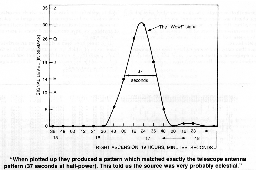 What Jerry had noted was a sequence of characters in Channel 2 running: 6, E, Q, U, J, 5. When plotted up they produced a pattern which matched exactly (within measurement error) the telescope antenna pattern. This told us that the source was very probably celestial, that is, fixed with respect to the star background and that it passed through the telescope beam with the earth's rotation. It was strong (30 sigmas or 30 times the background) and because it appeared in only one channel it was narrow-band (width 10 kilohertz or less). But even more significant, it was intermittent. A steady signal would have appeared two times on the record a few minutes apart as our telescope with its twin-beam scanned the sky.* (*The possibility that only one horn was functioning at the time can be ruled out because the two horns are balanced and, if one were
out, the system would have been inoperative.) So it was an "on and off" signal! Was it intended for us?
What Jerry had noted was a sequence of characters in Channel 2 running: 6, E, Q, U, J, 5. When plotted up they produced a pattern which matched exactly (within measurement error) the telescope antenna pattern. This told us that the source was very probably celestial, that is, fixed with respect to the star background and that it passed through the telescope beam with the earth's rotation. It was strong (30 sigmas or 30 times the background) and because it appeared in only one channel it was narrow-band (width 10 kilohertz or less). But even more significant, it was intermittent. A steady signal would have appeared two times on the record a few minutes apart as our telescope with its twin-beam scanned the sky.* (*The possibility that only one horn was functioning at the time can be ruled out because the two horns are balanced and, if one were
out, the system would have been inoperative.) So it was an "on and off" signal! Was it intended for us?
Bob, Jerry, Dick and I had urgent discussions about its significance. We soon were referring to it as the "Wow!" signal. We decided that we should continue to scan the same region of sky on the chance that the signal might reappear. But it never did, and after weeks of patient listening we moved on with our survey to other parts of the sky.
We checked star catalogs for any sun-like stars in the area and found none. We consulted ephemerides and made inquiries to see if any space probes could have been in the area and found none. The region is near the galactic plane and not too far from the center of the galaxy. Although it is not far south of the ecliptic (the plane near which most solar system objects are found and toward which a probe might be travelling) the moon, the major planets and even the four largest minor ones were all far removed in position and the Voyagers had not yet been launched. So we drew a complete blank.
Since then many improvements have been incorporated in our equipment so that now we could tell a great deal more about any signal. But we can't turn the clock back; we have to settle for the data we have which, nevertheless, is considerable and is impressive. The signal we got is by far the most suggestive of an extraterrestrial intelligent origin of anything we have detected in 6 years of searching.
What was it?
(1) It could have been a signal from an earth-launched space probe of which we are unaware. This is the most likely possibility. A signal from one of our distant space probes would be an "extraterrestrial intelligent signal" but it would be man-made.
(2) It could have been a signal from an extraterrestrial civilization which was turning on and off (or sweeping by) and we just happened to catch it for one full antenna pattern. But since it has not returned, so we could study it further, this is pure speculation. (If a pulsar had only been detected once on one fleeting transit, no one could have concluded anything from it). So until the signal comes back again and again for further study we can only wait and wonder.
Notes: (1) We were searching deeply enough for us to assume that there was always, on the average, a candidate star (with intelligent civilization) in the antenna beam. Hence, as in our earlier sky mapping survey, we were scanning the whole sky systematically and uniformly without stopping to examine any point in the sky more than any other unless something like the "Wow" signal came along.
(2) As of August 1977 the computer print-out had not yet been corrected for horn squints in both right ascension and declination so that the apparent position on the print-out is not the true value.
(3) Operation continues with the small group of dedicated volunteers.

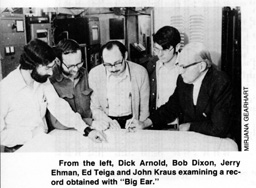 John Kraus is the Taine G. McDougal Professor of Electrical Engineering and Astronomy at the Ohio State University and the Director-Founder of the Ohio State-Ohio Wesleyan Radio Observatory where the O.S.U. radio telescope is situated. Born in Ann Arbor, Michigan, in 1910, he received degrees through the doctorate from the University of Michigan and, prior to joining the O.S.U. faculty in 1946, was employed by the U.S. Navy and Harvard University. Author of widely-used textbooks on antennas, electromagnetic theory and radio astronomy, and of hundreds of articles, he is the inventor of many types of antennas. He is the recipient of the Sullivant Medal of the Ohio State University and is a member of the National Academy of Engineering. Kraus is Editor of COSMIC SEARCH.
John Kraus is the Taine G. McDougal Professor of Electrical Engineering and Astronomy at the Ohio State University and the Director-Founder of the Ohio State-Ohio Wesleyan Radio Observatory where the O.S.U. radio telescope is situated. Born in Ann Arbor, Michigan, in 1910, he received degrees through the doctorate from the University of Michigan and, prior to joining the O.S.U. faculty in 1946, was employed by the U.S. Navy and Harvard University. Author of widely-used textbooks on antennas, electromagnetic theory and radio astronomy, and of hundreds of articles, he is the inventor of many types of antennas. He is the recipient of the Sullivant Medal of the Ohio State University and is a member of the National Academy of Engineering. Kraus is Editor of COSMIC SEARCH.
|
|
Computers and the Garden Path
By: Robert S. Dixon
[Article in magazine found on page 35]
While carrying out a recent computerized literature search for published material about SETI, a hitherto unknown technical article title was found which sounded very promising: "Doppler-independent Selective Heterodyne Radiometry for Detection
of Remote Species." Well now, isn't "Detection of Remote Species" what SETI is all about? And after all, don't most actual searches use radio telescopes whose receivers are "radiometers" which are "selective" and use the "heterodyne" method? And doesn't the motion of the Earth and the other species' planet generally cause "Doppler" frequency shifts that make it difficult to predict their exact frequency? Wouldn't it be great if somebody had finally figured out a neat way to get around this difficulty by making his receiver "Doppler-independent?"
With great anticipation, a mad dash was made to the library to look up this new article that was just sure to revolutionize SETI. A glance at the illustrations was encouraging. A skim through the abstract was vaguely troubling. A careful reading of the text
was devastating. Alas, the article was not about SETI at all. The computer and the English language had conspired to lead us astray.
What was the article really about? Write to COSMIC SEARCH and give us your best guess. (No fair looking up the article yourself). We'll publish the guesses and the correct answer later.
—Robert S. Dixon
P.S. A second careful reading of the text suggested that maybe after all....
|
|
ABCs of Space
By: John Kraus
[Article in magazine started on page 36]
A. Stars and Their Spectra; the Sun-like Stars
B. SETI Wavelengths
C. Radio Telescope Range
|
A. Stars and Their Spectra; the Sun-like Stars
Are all stars alike? No indeed, there are many different kinds. The list is long and their names are intriguing. There are red giants, blue giants, white dwarfs, red dwarfs, yellow dwarfs (our sun is one), infra-red stars, neutron stars (or pulsars), black holes and many more. Stars may also be described as old, young or middle aged, first generation or second generation.
At birth a star is an infra-red type. After maturing it may spend a long time, measured in billions of years, in a relatively stable state (the sun is at present in this condition). Growing older it may become unstable and explode as a nova or supernova, its remnant collapsing into a white dwarf, a pulsar or a black hole. During its lifetime a single star may be an infra-red star, a yellow dwarf, a red giant and a white dwarf so that many of the different names simply indicate the age or condition of a star.
It is a remarkable achievement that astronomers have been able to learn so much about the age and evolution of stars because stars live for billions of years while our knowledge of them is very brief. The situation is like that of a mayfly, which lives for a day, trying to comprehend the human life cycle from what it can see of a holiday crowd at a picnic. The mayfly is not able to watch a certain infant grow through childhood to maturity. The mayfly must infer that the different sizes and conditions of the humans, whether active or infirm, are indicative of their age. Like a mayfly, the astronomer has inferred from his brief view of the stars something of their age and evolution.
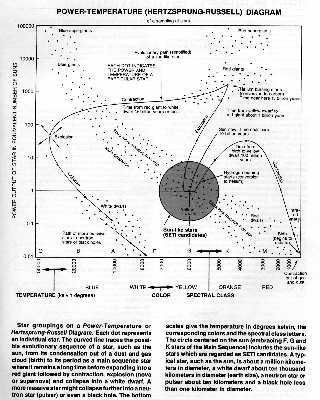 One of the great strides towards an understanding of stars was taken by Enjar Hertzsprung of Denmark and Henry Norris Russell of Princeton in the first decade of this century. Working independently, they studied the relation of the power of stars to their temperature. With the aid of a Power-Temperature Graph, now called a Hertzsprung-Russell diagram [at the left], they found that most stars are in a well-defined region, called the main-sequence, extending diagonally from the upper-left to the lower-right of the diagram. But there are also stars at other parts of the diagram. Those at the upper-right are relatively cool (red) but very powerful, so they must be very large. They are called red giants. The star Betelgeuse is an example. The stars at the lower-left are relatively hot (white) but weak. Therefore, they must be small. They are called white dwarfs. The companion star to Sirius is a white dwarf. The sun, with an intermediate temperature of 6000 kelvin degrees, is a yellow dwarf star which is on the main sequence.
One of the great strides towards an understanding of stars was taken by Enjar Hertzsprung of Denmark and Henry Norris Russell of Princeton in the first decade of this century. Working independently, they studied the relation of the power of stars to their temperature. With the aid of a Power-Temperature Graph, now called a Hertzsprung-Russell diagram [at the left], they found that most stars are in a well-defined region, called the main-sequence, extending diagonally from the upper-left to the lower-right of the diagram. But there are also stars at other parts of the diagram. Those at the upper-right are relatively cool (red) but very powerful, so they must be very large. They are called red giants. The star Betelgeuse is an example. The stars at the lower-left are relatively hot (white) but weak. Therefore, they must be small. They are called white dwarfs. The companion star to Sirius is a white dwarf. The sun, with an intermediate temperature of 6000 kelvin degrees, is a yellow dwarf star which is on the main sequence.
When the light from a star is passed through a prism it is spread out into its spectrum of component colors or wavelengths as in a rainbow. By noting the strongest color of the spectrum an astronomer can determine the star's temperature. Thus, the temperature for a hot blue star may be 20,000 kelvin degrees while the temperature of a relatively cool red star may be only 3000 degrees. In addition to the broad colors (or broadband continuum radiation) there may be relatively narrow features called lines associated with particular atoms in the star. Each chemical substance has a unique pattern of lines, as distinctive as a finger print. Working like a detective, an astronomer can deduce from these lines what elements are present in a star.
From the spectral colors and spectral lines, astronomers have classified stars into spectral types covering the color range from blue to red by a series of letters: O, B, A, F, G, K, M. Hot blue stars are O or B types, cooler red stars are M types. The sun is an intermediate temperature yellow star of the G type.
What has all this to do with SETI? Simply that if one G-type star, the sun, has planets one of which, the earth, has intelligent life, we might do better to search for tell-tale signs of life associated with G-type stars than other types.
Thus, the nearer G-type stars have been considered as prime candidates for possible beacon signals. The first star at which Frank Drake pointed an antenna in his famous Project Ozma, is a G-type star, Tau Ceti (see COSMIC SEARCH for January 1979). Stars of the spectral types F and K are close enough to G to also be considered as likely candidates. The second star at which Drake pointed his antenna is a K-type star, Epsilon Eridani.
Summary:
- The temperature of a star is related to its color. Blue stars are hotter than yellow stars and yellow stars are hotter than red ones.
- A star follows a life-cycle during which it may at different times be an infra-red star, a yellow dwarf, a red giant and a white dwarf.
- The elements in a star can be determined from lines they produce in the star's spectrum.
- The sun is a G-type star.
- SETI searches are commonly directed at F, G and K stars because they are somewhat similar to the sun.
B. SETI Wavelengths
Wavelengths, wavelengths,
of them all,
Which is the best one
for THE call?
|
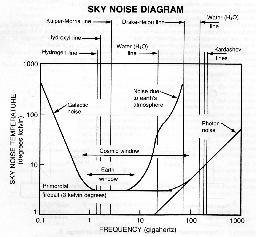 In a search for extraterrestrial intelligence, radio waves would seem, at present, to offer the best possibilities because there is a region between wavelengths of 1 millimeter to 30 centimeters (frequencies of 300 to 1 gigahertz) which constitutes a "cosmic window" for letting signals through. In this range of wavelengths natural noise is least. At longer wavelengths the galactic noise becomes stronger while at shorter wavelengths the photon noise increases. This is the situation in space. For earth-based observations the earth's atmosphere intervenes and this narrows the window on the short wavelength side, resulting in an "earth window". The situation is illustrated by the Sky Noise Diagram [at the right]. This diagram shows a portion of the one in the January 1979 COSMIC SEARCH in more detail.
In a search for extraterrestrial intelligence, radio waves would seem, at present, to offer the best possibilities because there is a region between wavelengths of 1 millimeter to 30 centimeters (frequencies of 300 to 1 gigahertz) which constitutes a "cosmic window" for letting signals through. In this range of wavelengths natural noise is least. At longer wavelengths the galactic noise becomes stronger while at shorter wavelengths the photon noise increases. This is the situation in space. For earth-based observations the earth's atmosphere intervenes and this narrows the window on the short wavelength side, resulting in an "earth window". The situation is illustrated by the Sky Noise Diagram [at the right]. This diagram shows a portion of the one in the January 1979 COSMIC SEARCH in more detail.
But for either the cosmic or earth window the actual number of channels is enormous and in order to narrow the choice many different proposals have been made for the "best" wavelength to use in searching for extraterrestrial intelligence. Hydrogen, the most abundant element in the universe, has a natural line emission at 21 centimeters. Giuseppe Cocconi and Philip Morrison suggested searching at or near this line (see January 1979 COSMIC SEARCH, page 5) and it has been a popular choice.
The hydroxyl (OH) line at 18 centimeters has also received attention. In fact, all the wavelengths between 18 and 21 centimeters, called the "waterhole" are considered attractive for searches (see ABCs of SETI, COSMIC SEARCH, March 1979).
Thomas Kuiper and Mark Morris have proposed a wavelength of about 12 centimeters, based on reasoning involving universal fundamental constants of nature.
Mention was made in the SEnTInel for March (1979) that Frank Drake and George Helou suggested a wavelength of about 4 millimeters based on bandwidth considerations.
In a coming issue of COSMIC SEARCH Nikolai Kardashev proposes a wavelength near 1.7 millimeters because the sky background radiation from the primordial fireball has a peak at this wavelength which is like a cosmic signpost. Kardashev has reasoned further that a slightly shorter wavelength of 1.5 millimeters may be closer to optimum.
Thus, we have eight different wavelengths in the range between 1 millimeter and 21 centimeters which have been proposed for various reasons. Are some better than others? Is one the best? Or is THE wavelength one we haven't yet thought of? No one can be sure.
For convenience, the proposed wavelengths are summarized in the SETI Wavelength Table.
Summary:
- The wavelength region between 18 and 21 centimeters is referred to as the (first) "waterhole."
- Second and third "waterholes" are at near 2 and 14 millimeters.
- Four other lines are near 1.5, 1.7 and 4 millimeters and near 12 centimeters.
- Although arguments can be advanced for each of the wavelengths no one can be certain which one may be best.
C. Radio Telescope Range
How far can a radio telescope reach? Ones no more than 50 meters in diameter detect radio sources known as quasars over ten billion light-year distances or practically to the "edge" of the universe. But quasars are enormously powerful. An extraterrestrial civilization would not necessarily be expected to have such a powerful beacon and be detectible at such great distances.
You may have read that a radio telescope with antenna diameter, for example, of 50 meters could communicate with a twin of itself over interstellar distances. How is this determined? It is a simple, straight forward calculation for any communication engineer. Let's see how it is done.
The basic relation is given by the Friis transmission formula expressed originally by Harald Friis, an engineer at the Bell Telephone Laboratories. Friis was Karl Jansky's supervisor at the time Jansky discovered radio waves of extraterrestrial origin (1931). The Friis formula is:
where R is the distance between the transmitter and receiver. Note that if the distance R is doubled the power received is only one-quarter as much.
Worked example:
Suppose the alien civilization transmitter power is 10 million (107) watts and that its antenna is 50 meters in
diameter (area equal to about 2000 square meters). Suppose further that the wavelength used is 21 centimeters (hydrogen line) and that the radio telescope antenna on the earth is also 50 meters in diameter. Then if the alien's star is 5 light-years (or 5 x 1016 meters) from our sun, we have

This received power of 4 tenths of one millionth of a trillionth of a watt is very small but many of our radio telescope receivers are thousands of times more sensitive. Thus, the alien society's signal could easily be detected and, conversely, a signal sent from the earth radio telescope could be received at the distant star assuming we transmitted with 10 million watts and the alien receiver was no better than ours. But there would be a 5 year time delay for the signals from the star to reach us and a 5 year delay for our reply signals to reach them, preventing any rapid repartee. Although we have made a few simplifying assumptions in our calculations (such as 100% percent antenna efficiency) the received power we obtained is of the correct order of magnitude.
Summary:
- With powers of 10 million watts and 50 meter diameter antennas, communication with present technology is possible over interstellar distances of 5 light-years or more (actually very much more).
- However, communication would be subject to time delays of 5 years (or more) each way.
|
|
In Review:
By: Editors
[Article in magazine found on page 40]
Murmurs of Earth by Carl Sagan, Frank Drake, Ann Druyan, Timothy Ferris, Jon Lomberg and Linda Sagan.
"Murmurs of Earth" is about the Voyager interstellar record. Is it a message for extraterrestrials or a message for ourselves? The chances of any extraterrestrial happening on it are exceedingly small but its significance for humanity is great because it
mirrors us as we try to put our best foot forward for a possible interstellar encounter. Will it be a capsule of a great
moment in human history as we enter a space age or will it be our epitaph?
"Murmurs of Earth" is an enthralling, thought-provoking account of the Voyager record, its message and how it came to be. Carl Sagan sets the tone, Frank Drake supplies technical details, Ann Druyan describes the sounds, Timothy Ferris the music, Jon Lomberg the pictures of earth while Linda Sagan details the Voyager's greetings. "Murmurs" is the inside story of the record, reflecting mankind's noblest aspirations as well as some of its foibles and hang-ups. The hassles over interstellar protocol are particularly revealing.
The Voyager record is a cameo of the earth and mankind's better side. The philosophy behind the record is perhaps best epitomized by President Jimmy Carter's message:
"This is a present from a small distant world, a token of our sounds, our science, our images, our music, our thoughts and our feelings. We are attempting to survive our time so we may live into yours. We hope someday, having solved the problems we face, to join a community of galactic civilizations. This record represents our hope and our determination, and our good will in a vast and awesome universe."
"Murmurs of Earth" is for everyone — an enduring testament for all time.
— John Kraus
*Random House, New York, 1978 (273 pages. Hardbound).
|
|
SETI Popular Topic in Colleges
By: Editors
[Article in magazine found on page 41]
Many colleges and universities are giving or planning to give courses on SETI. We have received information on a number of these as presented here. We would like to list other institutions where SETI courses are given. Please send information to Professor John Kraus, Editor of COSMIC SEARCH, Ohio State University Radio Observatory, 2015 Neil Ave., Columbus, Ohio 43210. Years given, attendance, a syllabus (if available) and other information will be appreciated.
Institution: San Diego State University, San Diego, California 92182
Instructor: John R. Sievers, Dept. of Astronomy
Title: Extraterrestrial Life and Space Colonization
Content: Introductory astronomy, life, probability of life in the galaxy, techniques of search, consequences of contact, space colonization, human requirements (physical, psychological and cultural), design and construction of a model colony, future considerations.
References: Shklovskii and Sagan, "Intelligent Life in the Universe", NASA Report SP-413 on "Space Settlements", and notes by instructor.
Year given: Spring 1979 (new course).
Enrollment: 60. Sievers writes: "I was astounded by the great demand for a course of this type on our campus. The course filled very quickly. Approximately 70 percent of the class consists of graduate and senior students."
Institution: Stockton State College, Pomona, New Jersey 08240
Instructor: Dennis Wildfogel, Assistant Professor, Division of Natural Sciences and Mathematics.
Title: The Search for Extraterrestrial Intelligence.
Content: Astronomy basics on stars, galaxies and the universe. Problems and significance of searching for extraterrestrial intelligence. Impact on our society. Class members will work together on a group project and make both a written and oral presentation. Wildfogel writes: "Although some very clever thinking has been done about communication with extraterrestrials, the field is so new and so subject to debate that there is a strong possibility that a student group can make a significant contribution."
References: Sullivan, "We Are Not Alone", Sagan, "The Cosmic Connection", and others.
Year given: Spring 1979 (new course).
Enrollment: Two dozen students representing almost as many major areas of specialization.
Institution: Consumnes River College, Sacramento, California 95823
Instructor: Wayne R. Anderson, Physics and Astronomy Department, and also instructors from the Anthropology and Biology Departments.
Title: Life in the Universe. 3-unit credit course co-numbered Astronomy 30 and Anthropology 30.
Content: Origin of solar system, origin of life on the earth, possibilities of extraterrestrial life.
Texts: Shklovskii and Sagan, "Intelligent Life in the Universe" and Orgel, "Origins of Life".
Years given: 3
Enrollment: 50 to 90
Institution: Menlo College, Menlo Park, California 94025
Instructor: Donald J. Albers, Chairman, Dept. of Mathematics
Title: Little Green Men and Bug-Eyed Monsters: Perspectives on Extraterrestrial Intelligence.
Content: Galactic perspective, is man alone or unique, intelligent neighbors, strategy of searching, space colonization, significance of contact. Basic theme is Carl Sagan's statement: "In a very real sense this search for extraterrestrial intelligence is a search for a cosmic context for mankind, a search for who we are, where we have come from and the possibilities there are for our future—in a universe vaster both in extent and duration than our forefathers ever dreamed of."
References: Shklovskii and Sagan, "Intelligent Life in the Universe", Bracewell, "The Galactic Club", Oliver and Billingham, "Project Cyclops Report" (NASA), COSMIC SEARCH, and others.
Field trip: To NASA-Ames Center on SETI Research.
Years given: 1978, 1979
Enrollment: 15
Institution: The Ohio State University, Columbus, Ohio 43210
Instructors: Terry Roark, Ph.D., Professor of Astronomy; Robert Ross, Associate Professor of Biochemistry; Mark Auburn, Ph.D., Associate Professor of English
Title: Extraterrestial Life: Probability and Possibilities
Content: An exploration of the question of the existence and nature of other life forms in the Universe. The sciences of astronomy and biochemistry will be used as a foundation for statements concerning the probability of such life while the literature of science fiction will provide a perspective for insight into and extrapolation beyond the probable. A non-credit,
continuing-education course for the interested layperson. Specialized knowledge in mathematics or the sciences is not required.
Year given: Spring 1979 (new course offering).
|
|
Off the Shelf
By: Mirjana Gearhart
[Article in magazine found on page 42]
The literature of SETI is extensive. In this and future issues of COSMIC SEARCH selected books and other publications are listed with pertinent information. Space prevents the inclusion of more than a small number in each issue. We believe you will find in these references much that will add to your knowledge and understanding while imparting something of the adventure and excitement of SETI.
Tom Allen, THE QUEST: A REPORT ON EXTRATERRESTRIAL LIFE, 1965, Chilton Books, Philadelphia, Pa. (310 pg., paperbound). A simple-to-follow, concise summary of man's quest for extraterrestrial intelligence.
Ben Bova, PLANETS, LIFE AND LGM, 1970, Addison-Wesley Publishing Co., Inc., Reading, Mass. (107 pg., hardbound). This famous writer of science fiction focuses his energies on speculating about life-in particular life in space.
Gosta Ehrensvard, MAN ON ANOTHER WORLD, 1965, The University of Chicago Press, Chicago, Ill. (182 pg., hardbound). In this translation of the original Swedish text, the author presents some of the universalities of life as it exists here—and possibly elsewhere. Ehrensvard views all of our evolution, our thrust into space, as stages preliminary to a broader sphere of interest.
V. Axel Firsoff, LIFE, MIND AND GALAXIES, 1967, Oliver and Boyd, Ltd., London, England (109 pg., paperbound). A monograph which looks at the biochemistries responsible for evolution on earth and presents alternatives we might consider as we search for life on other planets.
Hans Freudenthal, LINCOS, DESIGN OF A LANGUAGE FOR COSMIC INTERCOURSE, 1960, North-Holland Publishing Co., Amsterdam (224 pg., hardbound). The author presents the formalisms and terminology for a proposed cosmic language in terms of its mathematical structure, duration, behavior and mechanics.
Kenneth W. Gatland and Derek Dempster, WORLDS IN CREATION, 1974, Henry Regney Co., Chicago, 111. (232 pg., hardbound). The authors present the most recent developments in the fields of astronomy, space research, physics and biochemistry and add their own speculations about life in the universe.
Stephen Hanrahan, ed., THE SEARCH FOR EXTRATERRESTRIAL LIFE, 1967, American Astronautical Society, Washington, D.C. (378 pg., hardbound). Proceedings of the 12th Annual American Astronautical Society which brought together several hundred scientists and engineers to discuss and evaluate methods of conducting searches for extraterrestrial intelligence.
T. A. Heppenheimer, COLONIES IN SPACE, 1977, Stackpole Books, Harrisburg, Pa. (224 pg., hardbound). The story of how, using presently available technology like NASA's space shuttle, we can put humans into space so they might begin colonization of space.
Doris Jonas and David Jonas, OTHER SENSES, OTHER WORLDS, 1976, Stein and Day Publishers, Briarcliff Manor, N.Y. (240 pg., hardbound). An anthropologist and psychiatrist speculate on what kinds of life might inhabit other solar systems by examining what we can learn about the sense perceptions of other creatures on earth.
Ernst Mayr, EVOLUTION AND THE DIVERSITY OF LIFE, 1976, Belknap Press of Harvard University Press, Cambridge, Mass. (721 pg., hardbound). A collection of essays portraying the unity of evolutionary processes by natural selection and the diversity of living forms.
Frederick I. Ordway III, LIFE IN OTHER SOLAR SYSTEMS, 1965, E. P. Dutton and Co., New York, N.Y. (96 pg., hardbound). This monograph explores our solar system and discusses the possibilities and probabilities of life existing elsewhere.
Cyril Ponnamperuma, ed., EXOBIOLOGY, 1972, North-Holland Publishing Co., Amsterdam (485 pg., hardbound). Volume 23 in the Research Monographs in Frontiers of Biology, this contribution gathers together the writings of the world's exobiology experts on this vitally stimulating topic.
Brad Steiger and John White, eds., OTHER WORLDS, OTHER UNIVERSES, 1975, Doubleday and Company, Inc., Garden City, N.Y. (245 pg., hardbound). A collection of essays by 16 scholars and thinkers on subjects that range from Earth's prehistory to plasma-bodied biologies.
G. M. Tovmasyan, ed., EXTRATERRESTRIAL CIVILIZATIONS, 1967, Israel Program for Scientific Translations, Jerusalem NASA TTF-438 (99 pg., paperbound). A collection of papers by Soviet scientists about the experimental and technical aspects of SETI. Proceedings of the 1964 Byurakan Conference translated from the Russian.
Alfred R. Wallace, MAN'S PLACE IN THE UNIVERSE, 1903, McClure, Phillips and Co., New York (326 pg., hardbound). An historic book about turn-of-the-century scientific research into the plurality of worlds.
|
|
Extraterrestrial Life: Where is Everybody?
By: Jesco von Puttkamer
[Article in magazine started on page 43]
This article appeared earlier in "Future" magazine. Reprinted by permission of the author, Jesco von Puttkamer, Copyright © 1979.
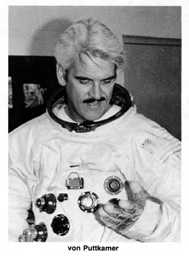 The results from the Viking search-for-life experiments on Mars will undoubtedly continue to fuel fierce debate among exobiologists for a long time.
The results from the Viking search-for-life experiments on Mars will undoubtedly continue to fuel fierce debate among exobiologists for a long time.
For science, the discovery of life on Mars would have been a momentous achievement, adding immeasurably to our understanding of the nature of living beings on earth and the origin of life. For humankind at large, it would have been a monument to our time with lasting impact on our view of nature and our philosophical beliefs. As it is, one of the greatest scientific and engineering enterprises of the 20th century has yielded results that, in their final consequence, are neither positive nor negative but inconclusive—and very definitely far from final.
While the Viking robots may have dealt a crushing blow to overly optimistic expectations about the existence of Martian life, the search for extraterrestrial life goes on unabated, perhaps even with increased vigor, driven by the immense importance to humankind which a positive result would have. With highly complex organic molecules, possible building blocks of life, being discovered constantly between the stars by radio-astronomy, exobiologists view life in the universe today as a common occurrence. Since conditions in the immense reaches of the cosmos are increasingly found to be similar to the conditions that prevailed on earth when life originated here, they feel that the universe must be teeming with it.
Man's conviction about the existence of other life forms beyond earth is not a development of our modern, scientific age. As early as in the 4th century B.C. the Epicurean philosopher Metrodoros wrote,
"To consider the earth as the only populated world in infinite space is as absurd as to assert that in an entire field sown with millet only one grain will grow."
And on 17 February 1600, early in the morning in Rome, Italy, after eight years of interrogation and solitary confinement, the "renegade" Dominican monk Giordano Bruno was burned alive at the stake on the Campo dei Fiori by the Roman Inquisition for—among other things—supporting the Copernican view that the earth revolved around the sun and that the universe was full of planets populated with living beings. (History has it that Giordano died after scoffing at his executioners and averting his eyes from the proffered crucifix.)
Unfortunately, while all modern astrophysical facts back Giordano's view today, evidence is still lacking, and exobiology remains a science that "has yet to demonstrate that its subject matter exists," as paleontologist George Gaylord Simpson put it. In the absence of life forms other than those on earth, all discussions about extraterrestrial life can only be speculative.
What makes the problem so intractable is the random nature of biochemical evolution itself. We know that for life to emerge, matter must interact in all three of its basic interactions: gravitational, nuclear, and chemical. While gravitational interaction, described by Newton's law, is simple to predict, and nuclear interactions, despite their very great number, also can be listed in all possible ways, the number of chemical reactions, both organic and inorganic, is so astronomically high that the prediction of the evolution of living organisms is an impossible task. The definition of a living system, thus, is saddled with a certain degree of subjective arbitrariness, to say the least.
Without ignoring the possibility that totally unearthly life forms could exist in the universe, our search for extraterrestrial life will be of considerably less speculative nature if we restrict it to biological forms known, beyond
the shadow of a doubt, to exist in the universe—namely, creatures on Planet Earth, built from carbon-containing molecules and water.
While silicon has been regarded by some (especially science fiction writers—remember the Horta from Star Trek?)
as another likely candidate for a base of life in the universe where its abundance is as much as 1/5th that of carbon, only
carbon is known to form such highly complex molecules as proteins (from amino acids) and nucleic acids (from sugars and nitrogenous bases, i.e., nucleotides) which can store and transfer the energy and the information that life appears to require to live up to its basic definition as a system of matter having mutability and heritability.
But while being "carbon chauvinists" about extraterrestrial biochemistry, we do not presume that its products would necessarily look like terrestrial forms. In fact, due to the randomness of biological evolution, they will almost certainly be different. Chauvinistically speaking, the bestiary out there, if any, will be exotic in the truest sense of the word!
For example, do they require an oxygen atmosphere? Not necessarily. Even on earth there are many life forms, such as certain bacteria and protozoans, which use inorganic materials for metabolic chemosynthesis without oxygen; and, of course, there are those plants that use photosynthesis. While life on earth almost certainly originated in a primeval non-oxygen atmosphere of hydrogen, ammonia, water vapor, and methane, higher life forms would have had a hard time to make a living if that atmosphere hadn't changed, over the millenia, to an oxidizing environment. That is because oxidation (combustion) of sugar (glucose, C6H12O6) into CO2 and water liberates over eleven times as many calories of energy as the fermentation of glucose into ethyl alcohol and CO2 in a reducing atmosphere (like Jupiter's, for instance.) Beings on such a world, to derive the same amount of free energy, may conceivably be too preoccupied with seeking food to develop a higher mind, technology, and civilization.
"We could be privileged to be among the earliest intelligences, standing in the dawn light of life in the universe."
In the absence of any clear evidence for or against the occurrence of extraterrestrial life forms, scientists had to begin their search by taking recourse to logical reasoning based on statistics, the game of juggling the odds of various astrophysical, biological, and social developments in Creation which are presumably necessary to biological and civilizing evolution. The overall estimate is obtained by multiplying many conditional probabilities of these outcomes, but there is a catch: in multiplying odds we are also multiplying possible goofs in our estimates, and so the likelihood of deriving a good judgment decreases as we proceed.
There are about 200 billion stars in our galaxy alone (and there are at least 100 billion other such galaxies in the universe.) But how many of those stars have planets with a mass not excessively different from that of the earth, with an adequate axial rotation and an atmopshere, which lies in the temperature zone permitting sustained carbon/water-based life, i.e., not too far from its sun to be permanently frozen nor too near it for its surface to be scorched?
Life on earth took an estimated 4 billion years to evolve from the earliest molecular system which we would call alive, to present-day humans. Prior to that, spanning at the most about one billion years, there was a period of chemical evolution, preceded by the initial condensation of the sun and its planetary system from glowing stellar gas. Thus, life must have originated hard and fast as soon as conditions were right—additional evidence for its suspected abundance in the universe—but it took many billions of years to evolve through its random processes of mutation and selection. Hence, we must look for stars that shine dependably steady, retaining constant radius and luminosity by burning hydrogen in nuclear reactions into helium over many billions of years.
Such stars are found on the so-called Main Sequence of the Hertzsprung-Russell diagram of brightness vs. surface temperature, classified in spectral types O, B, A, F, G, K, M, and N but only stars cooler than late F-stars and hotter than late K- or early M-stars may provide the temperature regime agreeable to higher protein life forms.
Another possible limitation is the existence of multiple stellar systems, especially binary stars which consist of two stars revolving around each other at separations ranging from virtual contact to half a light year or more. They are quite frequent; it is known that at least half the stars in the solar neighborhood are binary systems. To permit stable planetary orbits, the two stars must either be quite close together or very far apart. Because of the complicated orbits planets around many of these double stars would have, they may be less suited to be associated with life-bearing planets.
Are single stars always accompanied by planets? There is no definite answer but the currently valid theory of the origin of stars would suggest that planetary systems are widespread. Planets form from dust and gas that is either left over from the process of star condensation or that has been acquired from the gases in interstellar space. If the dust/gas cloud is massive enough, another star could form instead of planets, creating a binary system. Thus, planetary systems and double stars appear to have the same origin, and since binaries are very numerous, planetary systems should also occur frequently. It is likely that the majority of all single stars plus many double stars have planetary systems, and we are probably quite safe in assuming, for statistics' sake, that each star—on the average—has one habitable planet.
But what are the chances that life would indeed develop on such a planet? And that it would evolve into a civilization of intelligent beings? Estimation of these numbers is an even less definite exercise. But scientists today see life as a common occurrence in the universe—in fact, amino acids, the building blocks of life, have been found in space, and perhaps even life itself may have formed not on earth at all but out in space in the stellar nebula during the formation of the solar system—and it is likely that the appearance of intelligence, as a selective advantage of evolution, is the rule rather than the exception in the life history of a planet. And while technology is neither necessary nor sufficient for intelligence, all intelligence based on some form of genetic memory that wants to grow into society and civilization, must sooner or later apply natural laws through technology and engineering to assure its survival and protect its evolutionary potential by dealing with its enviromnent, expanding and diversifying it.
In a "Cultural Evolution Workshop" in 1975, chaired by Joshua Lederberg, scientists from NASA and various universities agreed that better than one in one-hundred of living species in space develop both intelligence and a technology corresponding at least to the electromagnetic communication phase.
With 200 billion suns in our galaxy, of which the oldest are about 12 to 18 billion years old, the average rate of star formation over the galactic history must have been about 10 stars per year. Applying our odds from above, we would then arrive at the conclusion that every 10 years one civilization must have appeared (10 stars per year x .01 civilizations per star). If we further assume that after the birth of the universe in the "Big Bang" it took 5 billion years for conditions to settle down enough for life to burst forth, we are left with 10 billion years during which as many as one billion civilizations could have appeared. How many supercivilizations (i.e., civilizations that are substantially in advance of our own), then, exist in our galaxy today?
That number obviously depends on the average lifetime of your typical civilization and, thus, on how much faith one has in technological intelligence. Our species has managed to survive 33 years since the development of the A-bomb. Can we make 100 years? What if the average life of a technological civilization cannot exceed 100 years because of self-destruction in one way or other? There would then be only 10 coexisting civilizations in the entire galaxy! To demonstrate how subjective this type of judgment really is, the reader may choose his/her own estimate of the mean longevity of a civilization and select the appropriate value for the number of presently existing supercivilizations in our galaxy from the table given here.
MEAN LIFETIME
OF CIVILIZATION | NUMBER OF COEXISTING
SUPERCIVILIZATIONS |
|---|
| 100 years | 10 |
| 1000 years | 100 |
| 10,000 years | 1,000 |
| 100,000 years | 10,000 |
| 1 million years | 100,000 |
| 10 million years | 1 million |
| 100 million years | 10 million |
| 1 billion years | 100 million |
What do exobiologists think? The opinions differ widely, but leading U.S. and Soviet scientists, like I.S. Shklovsky,
Carl Sagan, Frank Drake, Cyril Ponnamperuma, Melvin Calvin, N. S. Kardashev, Joshua Lederberg, and A. W. Cameron, to name just a few, generally agree on a "best guess" of one million civilizations at or beyond our present level of technological development, based on a mean longevity of ten million years.
The central question and main dilemma today, first expressed in this form by Enrico Fermi, is, "Where is Everybody?" Civilization appears to be a universal phenomenon, and yet there are no currently observed signs of cosmic activity of intelligent creatures. If there are at least one million supercivilizations in our galaxy alone, how can we explain the conspicuous absence of what Shklovsky has called "Cosmic Wonders"?
One answer has to do with the sheer size of the Milky Way galaxy. If one million civilizations are distributed randomly through space, the distance between us and the nearest of them would be about 300 light years. Another possibility is that supercivilizations may pass relatively rapidly through the stage where they radiate observable electromagnetic energy into space; even on Earth, we are approaching the time when such advances as cable-TV and communications satellites with directed spot beams will reduce sharply the amount of signals sent wastefully into outer space. Thirdly, would we recognize intelligent cosmic activity when we see it? What exactly is life, what is intelligence? Or—worst of all—the answer may be in our table above: lack of longevity of civilizations.
The possibility of receiving signals from extraterrestrial communities is one of the most intriguing problems raised by modern science. What are those signals, where and how are we to look for them, and should we devote time and effort to this search? The success of exobiology in solving its fundamental problem, to prove the existence of extraterrestrial life, depends largely on the level of our space technology—but are we ready? Contacting intelligent beings on another planet is undoubtedly the most fascinating aspect of space exploration, but what are the chances of success? There are 14 stars within a radius of 22 light years from our sun which may have inhabited planets (out of 111). Can we ever reach any of them? What about interstellar flight between civilizations? And would first contact, at least at the present critical stage of our development, have a salutary influence on humankind,—would it be beneficial or harmful? It's an area of inquiry which is as full of the stuff that wild-eyed fantasy is made of as it is braced with realistic, but exciting facts.
"Chauvinistically speaking, the bestiary out there, if any, will be exotic in the truest sense of the word."
For now, one final thought about our own existence and destiny: What if we are being too humble by assuming that ours is only a rookie civilization in a universe populated with a million or more supercivilizations? In our preceding analysis we used a rate of star formation averaged over the age of the universe, but in reality the number of suns in the beginning, billions of years ago, must have been quite small—and so may have been the opportunities for life to evolve. Maybe conditions for life, too, were unfavorable for longer than we have assumed above; maybe the threshold was not 10 billion years ago but more like 5 billion years. Then ours could be one of the very first planets with life in the universe, as Krafft Ehricke has pointed out. We could be privileged to be among the earliest intelligences, standing in the dawn light of life in the universe.
And the vigorous emergence of millions of other civilizations may take place in the billions of years to come—opening for us a future of truly breathtaking magnitude.
 Jesco von Puttkamer is Program Manager of Space Industrialization and Integrated Long-Range Planning Studies for the National Aeronautics and Space Administration (NASA) Office of Space Transportation Systems (Washington, D.C.). He is responsible for NASA's long-range studies in space flight, particularly for new applications of the Space Transportation System and concepts of permanent occupancy of space by humans.
Jesco von Puttkamer is Program Manager of Space Industrialization and Integrated Long-Range Planning Studies for the National Aeronautics and Space Administration (NASA) Office of Space Transportation Systems (Washington, D.C.). He is responsible for NASA's long-range studies in space flight, particularly for new applications of the Space Transportation System and concepts of permanent occupancy of space by humans.
Born in Germany, von Puttkamer received his Bachelor's and Master's degrees from the Technical University of Aachen. In 1961 he joined Wernher von Braun's rocket development team in Huntsville, Alabama. He has been involved in the Apollo, Skylab and Space Shuttle programs, receiving special NASA awards for his contributions to these projects. Von Puttkamer has written a number of books on space flight and in 1971 was chairman of the first international congress on "Space for Mankind's Benefit". He conducts a regular science column in "Future" magazine and is serving as science advisor for Paramount Pictures' new film "Star Trek."
|
Miscellaneous Items
Webpage Table of Contents (Bookmarks)
(Internal links to categories of items in this webpage)
Information About the Publication
(Editorial Board, Editors, Table of Contents)

ISSN 0161-8555
CODEN: COSEDN
Editors, and Others Involved in the Publication
Editor: John Kraus, Director, Ohio State University Radio Observatory.
Co-Editor: Mirjana R. Gearhart, Research Astronomer, Ohio State University Radio Observatory.
Co-Editor: Robert S. Dixon, Assistant Director, Ohio State University Radio Observatory
Business Manager: Sylvia Raub
Subscription Manager: Janet Stevens
Controller: Lesly Arnold
Assistants: David Raub, Norman Gearhart, Alice Kraus, Harold DeVries, Ann Cole, Janice Kraus, Richard Arnold, Wendy McKenna, Jerry Ehman
Editorial Board
- Richard Berendzen, University Provost, The American University
- John Billingham, Director SETI Program, NASA-AMES Research Center
- Ronald Bracewell, Director, Radio Astronomy Observatory, Stanford University
- Thomas A. Clark, NASA-Goddard Space Flight Center
- Arthur C. Clarke, Sri Lanka, author of "2001, A Space Odyssey"
- Norman Cousins, Chairman, Editorial Board, SATURDAY REVIEW
- Frank D. Drake, Director, National Astronomy and Ionosphere Center (Arecibo), Cornell University
- Robert E. Edelson, SETI Project Manager, Jet Propulsion Laboratory, California Institue of Technology
- Donald S. Hall, Director, Strasenburgh Planetarium, Rochester, New York; Past President, International Planetarium Society
- Theodore M. Hesburgh, President, University of Notre Dame
- Nikolai Kardashev, Space Research Institute, Academy of Sciences, Moscow, USSR
- Philip Morrison, Physics Department, Massachusetts Institute of Technology
- Bernard Oliver, Vice President, Hewlett-Packard Company; Director of NASA-Ames Cyclops Project
- Cyril Ponnamperuma, Director, Laboratory of Chemical Evolution, University of Maryland
- Martin Rees, Director, Institute of Astronomy, Cambridge University, England
- Carl Sagan, Director, Laboratory for Planetary Studies, Cornell University
- Walter Sullivan, Science Editor, New York Times
- Vasevolod S. Troitsky, Radiophysical Scientific Research Institute, Gorky, USSR
- Sebastian von Hoerner, National Radio Astronomy Observatory
About COSMIC SEARCH
COSMIC SEARCH is published by Cosmic-Quest, Inc. Copyright © 1979 by Cosmic-Quest, Inc. All rights reserved.
Cosmic Quest, Inc., is a private non-profit organization dedicated to the promotion and support of SETI endeavors.
Subscription price: $12 for 6 issues in U.S. (and possessions), $16 elsewhere. Single copies: $2.50 in U.S. (and possessions), $3 elsewhere.
Address subscriptions and all other correspondence to: Radio Observatory, Box 293, Delaware, Ohio 43015.
Application to mail at second-class postage rates is pending at Delaware, Ohio, and at additional mailing offices.
Summer issue
This third issue of COSMIC SEARCH is a summer issue. The fourth issue is planned for September. Since there will be fewer than six issues for 1979, subscriptions will be automatically extended so that subscribers will still receive 6 issues for a one year subscription and 12 issues for a two year subscription.
The Covers (front and back):
The Covers: The Fermilab near Batavia, Illinois, with the 2 kilometer diameter synchrotron accelerator (front cover) and the 2.2 kilometer diameter Super Protron Synchrotron of the Center for European Nuclear Research (CERN) at Geneva, Switzerland (back cover). Both have the capability for generating large numbers of neutrinos as discussed in this issue's article by Pasachoff and Kutner.
Table of Contents (in magazine)
| Item | Pg |
|---|
| Neutrinos for Interstellar Communication by Jay M. Pasachoff and Marc L. Kutner | 2 |
|---|
| Extraterrestrial Politics by Michael A. G. Michaud | 11 |
|---|
| Bio-Cosmology: A New NASA Thrust by B. M. Oliver | 16 |
|---|
| Minds and Millenia: The Psychology of Interstellar Communication by Michael A. Arbib | 21 |
|---|
| We Wait and Wonder by John Kraus | 31 |
|---|
| Extraterrestrial Life: Where is Everybody? by Jesco von Puttkamer | 43 |
|---|
| Features | |
|---|
| Glossary | Inside Front Cover |
|---|
| Letters | 9 |
|---|
| Next Issues | 10 |
|---|
| With the Editors | 10 |
|---|
| Editorial by the Washington Post | 15 |
|---|
| The SenTInel (SETI News) | 26 |
|---|
| Puzzles | 35 |
|---|
| ABCs of SPACE | 36 |
|---|
| In Review | 40 |
|---|
| SETI Popular Topic in Colleges | 41 |
|---|
| Off the Shelf | 42 |
|---|
| Summertime Wisdom | 48 |
|---|
With the editors—
With the support of our distinguished Editorial Board, we have set a high goal, to produce a popular yet authoritative, responsible new magazine dealing with a very important, exciting idea. We are striving for a magazine of an educational-scientific type that is easily understood and fun to read. We believe that the first issues approach these aims and the excellent material we have for coming issues should help us to do even better.
The magazine now has about three thousand subscriptions but we really need several times as many to put the magazine on a self-sustaining basis. You can help by urging others to subscribe, extending your own subscription or by making a donation (see "Donors Needed" in next column [below]).
As you know, the magazine is published by Cosmic-Quest, Inc. a non-profit, educational-scientific corporation which a small group of us organized to promote SETI endeavors, With the exception of Janet Stevens, Subscription Manager, a part-time hourly employee, we and the rest of the staff are unpaid volunteers with full-time responsibilities not related to the magazine. It has not been easy for such a small group to publish a magazine like COSMIC SEARCH but what we lack in size we make up for
in dedication and hard work.
We greatly appreciate the many letters of comment and encouragement we have received. Please keep them coming.
—Mirjana R. Gearhart, John Kraus and Robert S. Dixon
Donors Needed
Donations are needed to help COSMIC SEARCH continue. Donations may be made as follows:
Planetary: $30 per year
Stellar: $100 per year
Galactic: $500 per year
Cosmic: $1000 per year
Payments should be made to Cosmic-Quest, Inc., Box 293, Delaware, Ohio, 43015.
You may designate $12 of the amount for a six issue subscription making the remainder hopefully eligible for tax-deductible status as explained below. Galactic and Cosmic Donor-Subscribers will receive the magazine via first-class mail. We wish to list donors by name and city in COSMIC SEARCH unless you request otherwise.
Note re tax: COSMIC SEARCH is published by Cosmic-Quest, incorporated as a non-profit, educational-scientific organization under the laws of the State of Ohio. An application for tax-exempt status has been filed with the U.S. Internal Revenue Service (IRS) but until an IRS ruling has been received we cannot advise you that your contribution is tax deductible.
However, we hope to be able to report on the matter in COSMIC SEARCH before you file your tax returns for the year.
Coming in COSMIC SEARCH
- "The Possibilities of SETI from Space" by Roy Basler
- "Cosmic Languages" byHans Freudenthal
- "A Hymn to Life in the Universe" by Don Lago
- "Strategies of Searching for Extraterrestrial Civilizations" by Nikolai Kardashev
- "Quest Beyond the Stars: Are We Alone?" by Jesco von Puttkamer
- "The Grand Analogy: History of the Idea of Extraterrestrial Life" by Trudy Bell
- "Space Travel and Life" by E. J. Öpik
- "Chief Entities" by I. J. Good
- "Not as We Know It" by Isaac Asimov
- FORUM:
- Interview with scientist-philosopher John Archibald Wheeler on "Albert Einstein, Nils Bohr, Teaching and the Relationship of Art and Science"
- Interview with NASA's SETI Director John Billingham on "SETI"
- ABCs of Space will explain in simple terms:
- Three Degrees (The Big Bang Background)
- Doppler Shifts (Wavelengths are relative. The red shift)
- Radio Telescopes (What do they hear?)
- More SEnTlnel news reports, "Off the Shelf" books and other special features.
Glossary
- Anthropocentric:
- Man-centered.
- Astronomical Unit:
- A unit of length equal to the distance of the earth from the sun, about 150 million kilometers.
- Bandwidth:
- The wavelength or frequency range to which a receiver responds. Bandwidths can be described as narrow or wide, according to their range.
- Big Bang:
- The beginning event in the Universe. The explosion of this primordial fireball some 15 billion years ago caused the initial outward expansion of gas and dust which formed the universe.
- Blackbody radiation:
- Hypothetically radiation which is perfect; that is, all incident radiation is absorbed and re-emitted.
- CETI:
- An acronym for Communication with Extra-Terrestrial Intelligence.
- Doppler Shift:
- The resulting frequency change caused by the relative motion along a line of sight between two observers.
- Dyson Sphere:
- Shells built around stars by advanced civilizations. These objects are hypothesized by Princeton astronomer Freeman Dyson. These spheres might be detected by our astronomies as infrared sources.
- Electron-volt:
- The energy acquired by an electron moving through a potential difference of one volt.
- Exobiology:
- The study of extraterrestrial life forms.
- Galaxy:
- A large system of stars. Our galaxy, the Milky Way, is a spiral galaxy containing some 100,000 million stars, 100,000 light years in diameter and 10,000 light years thick.
- Gigahertz:
- A unit of frequency equal to 1,000 million hertz.
- Hertz:
- A unit of frequency equal to one cycle per second.
- Hydrogen:
- The most abundant element in the universe. It radiates naturally at a wavelength of 21 centimeters.
- Infrared radiation:
- Radiation whose emitted wavelengths are longer (redder) than those seen by the human eye, but shorter than radio wavelengths.
- Kelvin degrees:
- Absolute temperature measured in the celsius scale. Ten degrees kelvin equals ten degrees celsius above absolute zero.
- Lagrangian points:
- Five points (designated Ll, L2, L3, L4, and L5) in the plane of orbit of two mutually orbiting bodies where a third body, of relatively small mass, can remain in equilibrium with respect to the other two bodies.
- Light Year:
- The distance traveled by light in one year, about 10 trillion kilometers.
- Light (speed of):
- In empty space: 300,000 kilometers per second.
- Maser:
- A sensitive amplifying device employing energy jumps of atomic particles.
- Megahertz:
- A unit of frequency equal to one million hertz.
- Microwave radiation:
- Radiation in the short-wave radio spectrum having a wavelength range between 1 and 30 centimeters.
- Muon:
- An elementary atomic particle of mass intermediate between an electron and a proton.
- Nanosecond:
- One billionth of a second.
- Nucleon:
- A proton or a neutron, especially in the nucleus of an atom.
- Radio Astronomy:
- The science of making astronomical observations using instruments sensitive to radio wavelengths.
- Redshift:
- A shift toward the longer wavelengths of the optical spectrum due to recessional velocity (the Doppler effect).
- SETI:
- An acronym for Search for Extra-Terrestrial Intelligence.
- Ultra-violet radiation:
- Radiation whose emitted wavelengths are shorter (more violet) than those to which the eye is sensitive, but longer than x-rays.
COSMIC SEARCH AWARDS
For best papers on SETI
Category 1. Undergraduate students
Category 2. Graduate students
Category 3. Anyone else under 30 years of age
Papers may be on any aspect of the Search for Extra-Terrestrial Intelligence (SETI). Papers must be double-spaced typewritten with one inch margins on 8 1/2 by 11 inch bond paper and less than 2000 words in length. Any illustrations must be clearly executed.
Authors of best papers will be given a SEARCH AWARD of $100 and the paper will be published in COSMIC SEARCH. Authors should include their full address and telephone number. Authors should enclose a self-addressed stamped envelope if they wish to have their manuscripts returned. Manuscripts accepted and published are copyrighted and become the property of COSMIC SEARCH magazine.
Manuscripts may be submitted at any time. Their review is a continuous, on-going process. Each article received is reviewed by a special committee and if judged worthy, either in its original form or after revisions, will be given a SEARCH AWARD. The opinion of the committee is final.
A contestant may submit and have under review only one manuscript at a time and be eligible for only one SEARCH AWARD in one category. However, it is possible for one person to achieve SEARCH AWARDS sequentially in each of the three categories.
Address SEARCH AWARD Committee, Radio Observatory, P.O. Box 293, Delaware, Ohio 43015.
SEARCH PUZZLE
[Click on images below to obtain larger versions. In your browser you may need to uncheck the preference that says something like "Resize large images to fit in window" to avoid seeing a scaled image that appears smaller than the image below.]
Miscellaneous Quotes
The following quotes are not directly associated with any article. They are listed here in the order in which they appear in the magazine; page numbers are given. Uncredited quotes should be credited to the Editors of COSMIC SEARCH magazine.
Quote on page 9
"The invariable mark of wisdom is to see the miraculous in the common."
Ralph Waldo Emerson
Quotes on page 41
The Curvature of Space
An astronomer named Mace
Peered so far into space,
He was amazed to see
What sure seemed to be
The back of astronomer Mace.
— Sedgewick Seti
"Are life and mind irrelevant to the structure of the universe — or are they central to it?" John Archibald Wheeler in the American Scientist.
Quote on page 48
Summertime Wisdom
by Ken Cottrell
In the season of winter a wise man came
With words quite convincing, our cause to defame.
"Prideful vanity! The most endless quest!
Why not let the heavens rest
From your hopeless, irrelevant probing?
Some of your number in anguish have said,
'Where one question's answered ten others are bred.'
Why not direct your talents instead
To pursuits which are not so confusing?
Astronomers are mortal. They cannot discern
The model on which infinities turn.
When will arrogant mankind learn
That God resists such striving?
Are you not aware of the homeless and poor?
Has it escaped your attention that we face the last war?
Why go on considering fanciful theory-worlds more
When you know that this real one could be dying?"
Then a summertime wise man chanced by our door
With words more convincing than the wise man before.
"Press on good explorers of the cosmic main.
Never heed the voices of scorn and disdain
While pristine Edens go hopelessly begging.
No question posed will you fail to resolve
From the primal explosion to how planets evolve.
By your unyielding efforts all mysteries dissolve.
The veil of 'forever' is rising.
The unitive power of your glorious art
Transcends the walls which hold nations apart.
We shall know that brotherhood decreed by the heart,
Our souls released for true loving.
By your findings the earth is illumined with grace
Subtly inspiring our fear-ravaged race
To shatter this prison of time and of space,
To attain a new order of being."
Miscellaneous Photos
The following photo is not directly associated with any article. It is shown on this webpage at a relatively small size; click on it to obtain a larger size version.
Photo on Outside Back Cover
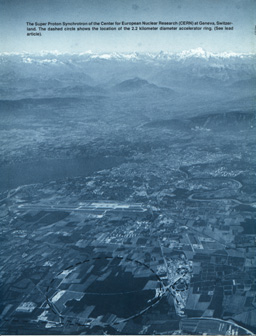
Miscellaneous Graphics
The following graphic is not directly associated with any article.
|
![[NAAPO Logo]](../../Images/NAAPOsm.jpg)








